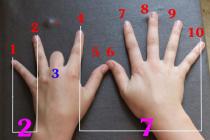Samsung goes to evolution after revolution ... again.
Our verdict
Powerful, durable, with a new interface. It's a shame that Samsung hasn't gone further with the design of its new device.
Device characteristics
- Built-in memory: 16 GB
- Main camera resolution: 16 Megapixels
- Battery talk time: 21 hours
- Screen resolution: 1920 x 1080
- Processor: Quad Core (4 Cores)
The Samsung Galaxy S5 can be summed up in one word: evolution.
The camera has been improved for sharper and faster footage. The fitness capabilities of the S5 have been improved over the Galaxy S4 with the more powerful S Health app and a built-in heart rate sensor. Also in the most secure phone Galaxy of all the existing ones has been added a fingerprint scanner.
The battery capacity is larger, the screen is wider and brighter, the processor is faster, and the design has been redesigned.
The list of characteristics of the device is definitely pleasing: 2.5 GHz quad-core CPU, 2 GB of RAM, a removable battery of 2800 mAh, 16/32 GB of internal memory (expandable up to 128 GB using a slot for a microSD card), one of the brightest screens in the world, 5.1 inches, and biometric features have also been added.

However, when you first pick up the Galaxy S5, it will be difficult for you to single out any one function that will attract a potential user.
A lot that doesn't matter, as Samsung has as many fans as its rival Apple, and many of them will not hesitate to pick the new Galaxy without looking at its competitors.
But now you can forget about it. The Galaxy S6 has been released, which has more, much more features for that.
The S6's design is more impressive: its metal-glass body makes it more iPhone-like than previous Samsung models. But the S5's design is definitely an improvement over its predecessors.

Power newest phone above, but it has lost the microSD card slot and removable battery, and it is also not waterproof. If all this is important to you, then it is better to buy the S5, as the prices for it have dropped.
It's a wise pricing choice, but if you are shocked by the cost Samsung Galaxy S5, then, apparently, you did not pay attention to the previous flagship models. In fact, in some countries it costs a little less than before. Prices have dropped relatively recently and the SIM-free option is now priced at £ 370 in the UK.
As you can imagine, offers with contracts are now almost everywhere, in this version the Galaxy S5 has the same price as the HTC One M8, but it is cheaper than the iPhone 6.
Samsung took notes from Galaxy S5 users, but focused not on something new, but on what makes the phone special for the consumer.
The company promised a "stylish" and "shiny" design, a camera that works the way you want it, and waterproof.
Little hint - there is information that will probably be released in February Samsung version Galaxy S5 Prime with more RAM, faster processor and QHD display.
However, this announcement was withdrawn (possibly due to problems with the creation of the new screen), and it was only in South Korea that the Samsung Galaxy S5 LTE-A version appeared. It is equipped with a Snapdragon 805 CPU, WQHD display, and all the high-end features you could wish for. In short, this is an amazing phone and I would love to see Samsung sell it all over the world.
You can always look at the Samsung Galaxy Alpha, a smaller phone that has the same power as the Galaxy S5, but with a lower 720p screen resolution. It has metal edges as Samsung has again relied on light weight over weight and ergonomics.
This phone has a high power, sky-high price tag and a low-resolution screen and premium design that rivals the new iPhone 6.

But if you want something smaller, then there is the Galaxy S5 Mini. It is the same as its bigger brother, but it has slightly fewer functions. It is not nearly as powerful, but it has an aesthetic design and a heart rate sensor. It's a great choice if you don't want to spend a lot of money.
But enough comparisons: let's look at one of the key questions Samsung has to answer with its Galaxy S5: is it good enough for the market to compete with the latest high-end smartphones?
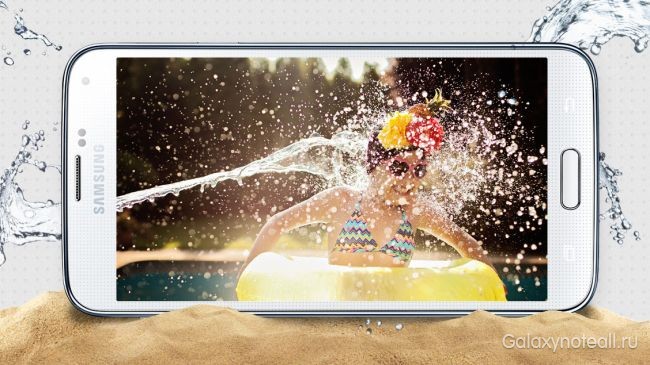
The simple answer that you can give in a second is no, because the design is not on the same level as that of Apple and HTC.
While this is only a small part of the story, under the hood Samsung continues its game by applying the latest technological solutions and optimizing them so that they do not quickly drain the battery.
Is this phone good enough to compete with Apple on the best-selling lists? Yes, but this is largely due to their worldwide marketing policy. But even that will not translate into huge sales of the new phone.
Samsung needs it for this last phone speaking the same design language (like Alpha and Note 4). The Galaxy S6 should be the dawn of a new era for the South Korean company, a device whose design will make consumers crave it.
A new iPhone 6 was a real winner by focusing on design. If buyers have not fallen in love with big screen S5, their desire for Apple is growing stronger (although before that, you will surely consider many great Android phones).
Samsung recently reported that it sold 40% fewer S5 phones than the Galaxy S4 in the same device lifecycle.
The South Korean giant responded to these events with plans to take a closer look at the strategy of this smartphone and focus on pricing rather than high-end devices.
What does it mean? Well, tentatively, we can expect some price cuts in the near future, which will make the Samsung Galaxy S5 more attractive.
Important for this review: The Galaxy S5 seems to be very little talked about, but that's not bad for a company accused of using useless innovation on last year's model.
I've always been careful when I talked about the design of a Samsung phone. The Galaxy S2, the company's first breakthrough, was mostly made of plastic, but was one of the few five-star phones.
Thus, year after year, Samsung failed to bring something new, some kind of wow effect, while other competitors confidently stepped onto the battlefield.
HTC is leading the way here with its one-piece metal One M8, and Apple has solidified its position with a refined design, the best since the iPhone 4, and has taken a big step forward with using iPhone 6.

Sony's efforts to develop the Z line have been rewarded with the Xperia Z3 with a modern design, and even Nokia has played with aluminum to give some of its devices a premium look.
All of this makes me wonder why Samsung refuses to give customers what they want ... called metal case?

Presumably, there are several reasons: the cost of production is too high, especially in the volume in which Samsung produces them, the company likes the lightness of the devices, it can be quite difficult to make a waterproof device out of metal.
However, none of these reasons have to do with reality, as Apple does all the same, but with metal phones. Devices with a certain weight are better than light ones, and a ruler Sony Xperia Z combines metal and water resistance seamlessly.

The Samsung Galaxy S5 is definitely more solid than the Galaxy S4 and looks more ergonomic thanks to its wider bezel, better grip and ribbed battery cover.
However, it doesn't look like a cutting-edge smartphone. With its metal frame, it is very similar to Galaxy Note 3 and S4, and I subconsciously start looking for the S Pen.
Samsung Galaxy Alpha is an interesting proposition that has similar Nokia Lumia 930 polycarbonate body and metal frame. It seems Samsung hasn't thought to do the same with the S5 - it bears little resemblance to a new concept that could boost its sales.
Its rear panel is also underwhelming. Although it seems to me that the comparison with a sticky patch would be a bit rude, it does give a "medical" feel, especially its white color.

The blue and copper options seem more appealing, but still don't get the same excitement as the HTC One M8.
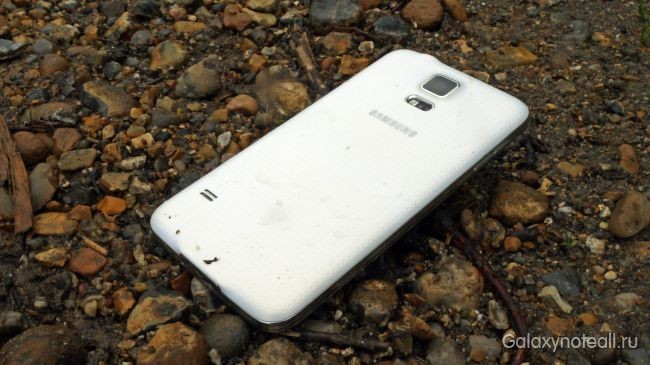
Despite the large screen, Samsung still does a great job with aspect ratios. Although the body has gotten bigger, it hasn't been incredible. But if you switched to this device after the old iPhone, you may find it somewhat difficult to operate.
Those who were fans before Samsung line Galaxy will find a lot to enjoy. The home button, which has a fingerprint sensor in it, is large enough to be easy to press, and the launch button, located on the right side of the phone, is raised a little higher for easier pressing.

The same can be said for the volume control button on the right. As the device has grown in size, it has become a little difficult for me to reach this area when I want to change the volume level while listening to music while walking.
One of the key changes in the Galaxy S5 is water resistance, it is IP67 certified, which means you can spill some water on it, but it is not advised to swim with it.
It's also dustproof, which makes the bare headphone jack even more impressive, as the S5 doesn't need a cap to cover the port.

A USB 3.0 connection that may seem superfluous to some, but the same was used in the Galaxy Note 3 for more fast charging when using standard microUSB cables with an increased IP protection class and some rigidity.
The gap designed for you to insert your nail there is small enough and perhaps the only thing that annoys those who want to get their hands on the best Galaxy phone do not care about its waterproofness.
The touch buttons are still next to the home button, but they are now slightly different. The menu button has been replaced with a multitasking button, which seems to be a Google favorite on Android 4.4.

You can still use it as a long-press menu button, but it doesn't work intuitively and is hard to reach on the right side.
It's not a bad system, and the physical home button, even less necessary than before, is still pleasant to the touch.
Another design win for the Samsung Galaxy S5 is the removable battery. It's mainly for peace of mind given the S5's battery life, but if you're worried about it breaking then this is a good option.
It also means that the ugly FCC stamp will be visible and you don't need a special tool to remove the SIM, and it's easier to insert a microSD card.

The lid is a cause for concern when considering waterproofing, as it can sometimes be difficult to make sure that all the fasteners fit into the grooves when closed.
A warning message appears on the screen reminding you of this, but you may need to check several times before making sure everything is closed.
If you look under the back panel, you will see that the battery is protected by a dense rubber coating, which means that if you drop the phone into water, you will be a little embarrassed, there is a large amount of water in the phone, but it will probably be all right.
I started to get worried when I noticed that sand got into the home button, but after an hour or two, it disappeared from there by itself, although it made me think about its dustproofness.

Generally Samsung design The Galaxy S5 is likely to be the part that gets the most criticism, and for good reason.
When it's in your hand, you don't feel like it's a premium device like many other high-end smartphones on the market, and while many talk about the high quality of the polycarbonate used in it, it still pales in comparison to the competition.
Yes, it's lighter, and probably stiffer (less likely you'll need a Galaxy S5 case, for example), but that's Samsung's biggest problem, something it tried to fix with the Galaxy S6.
Key features
Last year, it was difficult to talk about all the new elements of the Galaxy S4, as most of them brought almost nothing new, except for technological stuff.
Things like Air Browse still exist, they are still in the settings, and this is a complaint against Samsung, which still hasn't removed them.

Although the company has tried to make the Galaxy S5 phone more useful, it still keeps what customers use every day. Let's now take a look at the new features:
S Health
One of the most obvious things about the Samsung Galaxy S5 is the heart rate sensor on the back next to the camera.
It is designed in such a way that it will allow you to get more out of your daily activities, using the so-called quantified self applications that reflect all the data about daily activities.
S Health 3.0 is good update, and fills in many fields that are not available in other applications. You can install the best elements that S Health has to offer, such as My Calorie Counter, which calculates calories, but for convenience it is better to use it with the main application.
The pedometer, like most phones, is largely useless because it sets the number of steps you have to take daily, which you can only do if you glue the Galaxy S5 to your thigh.
It's not as accurate as what you put on your wrist or shoes, and Samsung has put a lot of effort into designing wearable gadgets, which seems to be more novelty than useful.
You can track your exercise progress on your phone as it adds data to a centralized system. Again, there are better apps for recording running, like Adidas MiCoach, Runkeeper or Endomondo, but this good app for novice runners, although it does not take into account the purpose of the run.

New to S Health this year on the Galaxy S5 is a heart rate sensor located on the back of the monitor next to the camera, so you can take your heart rate whenever you want.
But here's the thing: why do you need this? This is one of those elements that seems to be here just like that, because Samsung was trying to think about what it could add to the S5 to make it feel new and interesting.
And it, by and large, worked. But it is far from being as reliable as some gadget located on the wrist or chest (I found that it manages to calculate my heart rate every 3-4 attempts), in addition, the question arises when you want to use it ...
Ideally, if you remember that you want to measure your heart rate when you wake up, when you are relaxed and able to measure your heart rate at rest.

And maybe it will also be useful at certain moments of stress during the day, so that you can know the required fitness time, provided that you are using the app correctly.
But, in fact, you should not forget to do it in the right time That is, your average heart rate will depend on what you do during the day.
I know one person who has heart problems. I asked her what she thinks about this feature. She said the feature is indeed useful for those who need to measure their heart rate throughout the day, or simply check how fast their heart rate increases with exertion (although this is not enough for medical purposes).
Thus, S Health is a great app for those who have certain medical conditions and do not require very accurate data (the Galaxy S5 sensor is not intended to replace the corresponding medical equipment). But for the rest of the people, this thing falls into the "pub competition at lower heart rate" category.
Samsung, like many other big phone makers, is trying their best to extend battery life as it usually dries up by the end of the day.
As you've all seen in the battery graph, the Galaxy S5 is a great choice if you want to spend more time away from charging your phone, and this new tool makes you feel more confident when your battery starts to run low.

This feature starts working when you activate it, and not constantly. The screen turns black and white, the power decreases, there is still access to a limited number of applications - to 6 that you choose.
The choice is not so great (so you don't just waste your battery when you really need it), but includes Twitter and an Internet browser. This surprised me.
In this mode, the phone will only consume power when the screen is active, which means that you will not receive background notifications, etc. meaning.

For example, at 7% charge, I activated this mode, the phone informed me that the battery is now enough for 21 hours. An hour later, I decided to see how much was left again. However, I spent 3 or 4 minutes using my browser and then checked a couple of tweets. As a result, only 2% of the battery remained.
The good news, however, is that if you have 100% battery, you will laugh, as in this mode it will last for so many days if used wisely.
In fact, I advise you to use this mode wisely. Don't do something that drains your battery, just use your phone as a way to make a call or send a text message when you're not at home and desperately need some leftover battery power.
I was quick to call this mode useless when I first met it in Barcelona, and saying that you might as well just turn off your phone. But it's actually a good idea, and it works better than the similar feature on the HTC One M8, which doesn't set the screen to black and white.
The transition from normal to saving mode will take about 15 seconds, which is a bit long and tedious, so get ready to just activate it and put your phone in your pocket. If it were faster, then I would just turn the phone on and off as needed. Unfortunately, this is not an option.
Camera and selective focus
I'll talk more about the camera a little later in this review, but here are some high-end specs worth mentioning now, as this is one of Samsung's biggest achievements.

Selective focus (or background focus, whichever you want to call it) is an important thing for smartphone makers this year, as Sony, LG and HTC joined Samsung and gave it the opportunity to take a photo by giving it “ pro effect ”by defocusing the background with a bokeh effect, but keeping the subject in place. Nokia started doing this back in 2013.
HTC is the best at bringing this to life with the addition of an appropriate sensor to give more depth of information needed for this effect.

Unfortunately, Samsung seems to be the worst at this task, as the method used here often fails.
After you have turned on the camera, you need to select "Selective Focus" on the left side. Then, hope that the subject you want to shoot meets all the S5 parameters, as I often came across the message that the effect could not be applied because the subject in the foreground was not found.

The phone takes a few pictures and then processes them, again, not quickly. Then you go to the gallery and click on the icon to start processing the image, which will take a few more seconds. And, if everything is in order, then you can choose a blurred foreground or background, but there is no way to keep both options.
In general, this is a very clever feature, Samsung did a great job and is worthy of respect, but HTC did a great job with it in its One M8. It's a shame that the South Korean company did it later.
Fortunately, the rest of the camera's functions are better refined better: a more powerful sensor and instant autofocus are the main things users are interested in.

It seems the company hasn't done enough to address the flaws software as the camera is slow to start, especially from sleep mode.
I also noticed that autofocus is fast, but the shot is not always sharp, so Samsung's claim that the phone is great for taking any kind of image is not entirely true.
If there is good lighting and you know you want to photograph (and the camera is ready to shoot), then this is good system... but most of the time we use the camera in a very different environment.
In addition to the biometric features in the phone, this is a topic that can be infuriating, as many companies install it just to be.
Apple has done this for the first time with TouchID (accuracy issues aside) and companies in the industry have quickly begun to do the same.
The HTC One Max had a scanner on the back of the huge phone, but it was impossible to reach. Samsung has at least placed it on the home button, which is more conveniently located, but the accuracy is not as high as the Apple version.

It's not bad, and definitely the second on the market, but the Galaxy S5 asks you to swipe straight down instead of a normal gesture.
The good news is that you can conduct thumb on the button from side to side and it will work, but the accuracy is low. Only one of 7-8 attempts will be successful, and if your hand is slightly crooked, then you will easily exhaust all 5 attempts.
I found that it started to work worse after a few days, since it is possible to add up to three prints there, I deleted my first attempt and tried again, sliding my thumb down and from corner to corner. The sensor seemed to like it better, and the accuracy of unlocking the phone improved.
I used to delete the last attempts when there were problems, but I watched the subsequent deterioration in performance, and most users would not think about making new prints. As I said, after taking prints of the same finger in two different ways, I saw a change in accuracy, but perhaps this is not the only problem.
Download accelerator
Download Booster is one of the best ways to kill your traffic if you leave it on. I'm kidding, it won't hurt you if you have 4GB of extra bandwidth.
The point is simple: you have 4G, but you are connected when Wi-Fi assistance and want to download a file from the magic cloud world of the internet. Instead of using one speed, the forces combine to create super speed.

If something happens to one connection, the second will take over the load and continue downloading, which means that by downloading files that weigh more than 30 MB, you will have tremendous speed.
One thing is not clear - is it possible to use high-speed download when the LTE / 4G connection is disabled. The app says only super-fast next-generation mobile connections are available, but the icon at the top of the screen still says 3G.
However, this does not work, so it can be assumed that this is another Samsung mistake.
Display
Samsung Galaxy S5 display is one of the best on the market, and best characteristic phone. You can talk about additional innovation whatever you want, but if the phone has a big battery, a great camera and a good screen, then this is a winner.
I love what it offers - it's brighter than LCD panels, looks richer at full power than the HTC One M8. In addition, it can be darker than the rest (Samsung knows that many of us read in bed), but remain crisp.
![]()
According to DisplayMate, the Full HD Super AMOLED display is 22% brighter than the Galaxy S4 without requiring more power. Now you can go ahead and see what this stunning screen is capable of.
But here's the bottom line: The days when the Super AMOLED display was a color mess are over. Samsung has provided the Galaxy S5 with all sorts of customization options so you can find the exact balance of what you love. And features such as adaptive display are essential so that even in bright light, the information on the screen is clearly visible.
Unfortunately, this last mode cannot be used with all applications, only with basic ones such as browser, gallery.

Good brightness, high definition and better color rendering (by most opinions) will impress everyone but the most high standards and if you spend a lot of time watching movies, surfing the web or just flipping through photos, then this 5.1-inch 1920 × 1080 screen is the best choice.
It's unpleasant that the best option exists on both the LG G3 and the Samsung Galaxy S5 LTE-A version, since it is this option that makes the screen clear and bright and can improve even the most good display... But those technical fans always want something more.
If you think what Samsung phone buy, it is worth noting that the Note 4 also has an improved display, one of the best recognized on the market by DisplayMate.
Interface and performance
The interface on the Samsung Galaxy S5 has improved a lot over the S4 and previous versions of the Galaxy family.
This is mainly due to the new round icons and geometric layout, allowing everything to look a little more premium and fluid. You can argue that he's a bit skeuomorphic, but it's like a hint that he's trying to emulate Apple, although I don't think so.

At least I hope not. I don’t want to write anymore about any court cases.
Screen lock gets first place. Now it displays the weather and the pedometer with the number of steps taken.
There is also a shortcut to the camera icon in the corner, allowing you to easily enter the application without having to unlock your phone (although it can be difficult to get into if you clicked the icon incorrectly). This is especially useful function if you have a fingerprint screen lock set.
One of the best parts of the new home screen is the speed boost in TouchWiz. I was not the only one who noticed the lag in the interface, but S5 users say it is faster.
The animation of the transitions between desktops is still a bit slow as the pages get stuck at the top of each other, but this is negligible.
The notification bar is one of the features that has undergone significant changes, it now has the rounded font that I mentioned earlier, and it looks much nicer.
The settings menu is the same, but has been split into more sections for quicker access to what you want. Although, if you are already familiar with Android, it will take a while to get used to it.

Android Lollipop was launched not too long ago, and Samsung has already started rolling it out to the Galaxy S5. The update brings new features, including LockScreen, top notifications, MirrorLink and an improved fingerprint sensor, and new material design elements for the TouchWiz interface. But at the time of this writing, a lot of people are still waiting for an update for their phones.
Going back to the phone itself, it's worth noting Samsung's clear tendency to gather news on other devices, and continues to do so in the Flipboard with My Magazine, which lives on the left side of the main home screen.
Basically, the app takes Flipboard articles and integration methods and shows them in various categories, and this is not the most impressive improvement at all.
Once you have opened it, you will be asked to select topics that might interest you ... but what is News and Noteworthy Articles? What news does the "Sport" section cover? It is impossible to determine, so I instantly ran into a plethora of content that I was not interested in.
If you dig a little deeper, you'll find that Flipboard's Magazine has an interface that lets you set custom feeds and more, which is much better.

Flipboard's Magazine interface
This is a very controversial thing at Samsung, and My Magazine still needs a lot of work to be worthy, but for now, let me turn it off.
The quality of the news collected from most sources is not very good and intuitive, but I see in the not too distant future that the application will find content that interests me. So it would be nice if Samsung got this message.
But that doesn't mean Samsung doesn't have other new features that I love: for example, the Toolbox icon, which looks like a floating circle on the screen, allows you to choose five apps that can be accessed by tapping on it, wherever you are. in phone.
I don't want it to be active all the time, but you may run into situations where you need quick access to things like a calculator or a voice recorder, and this is a great way to do it.
Multi-window mode is still all over the place, but I suggest you turn it off. The point is, if you are trying to watch a video, the main application will not let you do this ... you can only preview some of the videos, and the one you choose can only be viewed in the second half of the screen.
It's the same with internet browser and apps, and it's really annoying when you don't want it.
Overall, I'm a little disappointed with the Galaxy S5's interface. There's power: 2.5GHz CPU from the excellent Qualcomm 801 chipset, which was the market leader when it came out and remains impressive now, but I still found a lot of slowdowns in some places.
The camera app takes a long time to launch, powerful games like Real Racing 3 have low frame rates, many machines freeze (although a reboot fixed this issue a bit), and opening the gallery takes a very long time if you have cloud storage.
It seems Samsung hasn't optimized its software in these areas, as using such additional features like RR3, the phone is overheating, which means that the phone cannot wake up effectively from sleep mode.
I've also noted multiple instances of the S5 freezing and crashing, ranging from Facebook to Gmail and SwiftKey. But now we have received a software update that has improved the situation somewhat, so this is not as bad as it was in the beginning.
This disappointment is compounded by the fact that when testing GeekBench 3, the phone received a decent 2909, which is slightly better than the HTC One M8.
It should be noted that HTC, unlike Samsung, has added a “high power mode” that allows these applications to get better performance. It's the same on both iPhone models, which means that in our time, the differences between high-end smartphones disappear.
There are very few differences between the four phones in terms of overall speed, but the issue with speed in gaming matters. Gallery loading speed has been an issue for a number of Samsung models, so I doubt that will change. But for a phone with a fast camera, something has to change.
I would like to draw particular attention to memory, given that Samsung has come under criticism for the weight of its operating system in the Samsung Galaxy S4. Out of 16GB of internal space, you get over 11GB for personal use, which is comparable to the best on the market.

This has been helped by the fact that Samsung has removed some of the less essential apps and made them available for download from its app store, which means you have more control over the internal space.
Battery and essential functions
Here's what I want to say: lifespan Samsung battery The Galaxy S5 is awesome. If you don’t want to keep reading, I don’t blame you.
There are two reasons for the improvement: first, you now have a larger 2800mAh battery, which obviously extends the life of the device. Second, you also got fast processor Snapdragon 801 tackles everything more efficiently and conserves battery life.
On top of it all, the screen also became much more efficient at the same brightness as the Samsung Galaxy S4, which was quickly draining its battery.
This needs to be put in context: in our video battery drain test, when watching videos for 90 minutes at full brightness, the Galaxy S5 only lost 16% of its charge, which is comparable to the iPhone 5S, which has a slower processor, smaller screen and fewer pixels. ...
It beats the 23% drop on the HTC One M8, which, if you've read this review, is good device in terms of battery life, so now you know how happy I was when I saw more impressive results.

In fact, only LG (of the big manufacturers) seems to be more adept at optimizing the battery life of their devices, so it's odd that it couldn't beat Samsung with the LG G3, but it has a QHD display that's hard to fight against.
The battery on the Samsung Galaxy S5 was so good that I started thinking about all the things eating up battery power quickly enough, so I checked the Maximum Power Saving Mode again. The phone lasted an hour or two of shooting, Real Racing 3 games (which is what really eats up the battery) and 2 hours of video playback before 25% remained.
This figure has been surpassed by several other phones recently, such as the Sony Xperia Z3 rival, but it is still the best.
These two power saving modes (maximum save mode and normal) work quite well. In normal power saving mode, there is also the option to turn your screen to black and white, which means you don't have to worry too much about the battery (again, you don't want to constantly look at your phone, which will also save battery power).
There is no way to reduce the power consumption of these apps, but perhaps this is a feature that Samsung will add at a later date.
Mandatory functions
It is worth recalling that at the heart of the Samsung Galaxy S5 is still a phone with some best features on the market.
For example, a company has merged social networks with contacts. The smartphone has tons of decent apps and widgets (we're still glad the flashlight widget is only one icon) and generally knows how to get the best out of its phones based on credentials.
Calls
Call from using Samsung The Galaxy S5, like most of its Galaxy siblings, is very enjoyable. It gives a clear and crisp sound. The reason we relegated it to the 'essentials' category is simply because most phones are good at it, but Samsung is still at the top in this regard.
There are also old familiar touches, such as the ability to see the last message you exchanged with whoever you're calling, and the ability to call back or send a message while the call is on hold.

The Galaxy S5's network coverage is more than acceptable, although not the best I've seen. This is a little disappointing because I expected more clarity from the connection to the towers. cellular communication phone, with a polycarbonate case.
Still, this phone does a great job of making calls to other people, and if that's what matters to you (other than, perhaps, the amount of money spent on such a high-end smartphone), then things could be much worse.
Posts
The phone messaging process has come a long way in recent years, and apps like WhatsApp and Facebook Messenger pose a real challenge for today's SMS.
Luckily Samsung is stuck with its messaging app, and isn't forcing you to use Hangouts on Android 4.4, which Google is aiming to get more people into, urging you to use the texting app the first time you download it.
In the new TouchWiz interface, Samsung has added another smart function as priority senders at the top of your mailbox... This means that the people you most often communicate with will always be available with a single tap in an open application.

The keyboard on the Galaxy S5 has mixed feelings. I always check the quality of the keyboard like this: do I want to download SwiftKey right away (one of best apps keyboard on the Android Play Store) or not, or I can work with what I have.
In that case, I think you could continue to use the Samsung keyboard if you don't have to use a lot of commas. It only has one full, visible, lettered stop key, which means you'll be frustratedly hitting it over and over again.
The keyboard should also match your style, but remember, there were times when it refused to type in a word I typed that was not in the dictionary.
Yes, I can say that I practically praise this keyboard, because Samsung does add terrible options, but you will probably still be happy to try out some of the other features. It is still not as good as the rest of the market.
Browser
Like most smartphones today, Samsung offers two browsers to choose from: its own and Google chrome... If you use the latter as a desktop browser, then you probably won't want to change it because it stores all your stories and passwords.
It would be a shame, because Samsung has given a really good option that not only looks good but is also very fast.
The interface is straightforward, with URL and navigation keys that go to the side when you start flipping through web pages. It has all the standard Chrome features like Incognito Mode and Desktop, so you don't miss a thing by switching between them.
The bookmarking system works intuitively and the saved pages work great in Pocket style.
As you might have guessed, most Android smartphones have the best browsers available today, but Samsung's solution with a download bar at the top of the page is very good.
Child mode
You can argue about its necessity, but for those who want to protect their children from smartphone entertainment, Child mode on the Galaxy S5 will be helpful.
This is standard procedure: you activate it, enter the code, show a photo of the child and set his age, so your boy or girl will know that it was done especially for them.
Then you can choose the apps they can use (which look like gifts on the home screen ... "Dad, look, this is Escape Zombie Land! Thanks!" ) and you can also set the amount of time for games.
From being able to click on terrain and search for hidden treasures, to painting, recording your voice, or viewing pre-approved media. This is a good app to take into account and add to the others.
I try to pretend that I do not accidentally play this mode for half an hour during testing. I can not. There is an application that allows you to record your own voice and play it backwards like a robot.
Camera
The camera on the Samsung Galaxy S5 is one of the most powerful on the market with Isocell and 16MP.
It has a number of other features that many will love, such as real-time HDR, which lets you see how your photo can be improved before you start shooting.
But the more interesting thing that grabs attention Samsung buyers- fast autofocus, which can adjust the clarity of the image in 0.3 seconds.

It's fast, and there is no doubt that he can actually set it up so quickly. However, I got a couple of complaints before I talked about it.
I already mentioned this, but for some reason, it can take a few seconds for the camera to load, which is slightly longer than the competition. If you are trying to use a “quick snapshot” from the lock screen, it can take even longer, since it is easy to think that you only clicked on the icon when in fact you get far enough.
It takes the camera 3 seconds to start shooting, which means if you are trying to capture a sudden moment, you will probably miss it.
The autofocus, which I mentioned earlier, is fast and often focuses on exactly what you want, especially when the composition is right. However, there were a few cases where I had to wait to take a picture and the autofocus was lost, although the subject was still blurred.
This is a non-standard situation - I wiped the lens or went into the settings to see what was going on, but I found nothing.
At least, HDR mode works well and is very nice to see it next to selective focus as one of the main options. You do get some of the best real-time HDR shots, and they don't take very long to process, which is a plus.

Selective focus is something of a mixed bag. On the one hand, it can work in macro mode, which means you can take multiple shots at close range and the background will be blurred. This is what you wanted (some competitors may not).
On the other hand, the device told me too often that it does not accept the image I took, and the image cannot be changed after it has already been taken.
The result was not blurry enough for me. If you compare it to the HTC One M8, which has a weak sensor, but high speed shutter release, better defocusing and better low-light shots, you know it's a minor feature for Samsung ... or at least it seems so.
But if it sounds like I'm opposed Samsung cameras Galaxy S5, I apologize. This is not true. It's a good and powerful sensor, but it takes more effort to get stunning images.
The larger sensor takes a little longer to process photos (we're talking nanoseconds for normal auto photos) and autofocus isn't as sharp as you'd like, but line up your shot and you'll definitely get a better image.
If you are trying to photograph in candlelight, then the S5 would be the best option. If you have a mesmerizing landscape, you will get better color reproduction with the S5.
Nevertheless, the modes are a little overkill, as there is no GIF animation before, I do not even find the desire to use any of the modes.
Samsung has typed these modes en masse since the overly complex S4, and it really helps. The Touch Up beauty mode never ceases to scare me, and although I love the Virtual Tour, I just can't seem to find the time to want to walk around my house.
This is one of only a few devices on the market with 4K video recording capability, however I think we won't need such a feature for at least a year or two. In addition, it will of course require more memory to shoot at this high aspect ratio.
The Galaxy S5's camera is competitive because it's powerful - it's not as good as the Nokia Lumia PureView sensor, but again, it's more responsive than the HTC One M8 if you're willing to put in the time.
Still, the One M8 is the best choice for everyday shooting, the sharpness is actually comparable to many of the S5's, but they are not as pleasant as I thought they would look when viewed on screen.
Sample camera photos
Now let's take a look at additional shots to show how the S5 handles fast action.





Another clear shot - the S5 performs well in bright light


Media
We've almost reached the point where there is very little that can be done with the phone in terms of music playback, video viewing and games.
Music
Samsung does not have the same technical support like HTC or Apple in terms of dedicated audio output amplification, which means your headphones have to work less to get rid of the output noise from your ears.
However, the volume of the Galaxy S5 is such that I would be surprised if there was nothing amplifying the sound from the software side.
The sound output, especially when paired with headphones, is amazing. I hear every little thing, every bass.
The music player interface is simple and straightforward - you can view all the music that the S5 collects from all over the phone at once. You can choose an album, song and playlist, plus a musical mood.
It was never what I used correctly - no one wants a playlist that goes from slow to energetic music, but it is good way listening to music with a kind of progression.

The sound coming out of the single speaker on the back of the phone isn't quite as powerful as from HTC's Boomsound or the Xperia Z3's front speaker, but it's okay for most purposes if you put it on a table and let the sound spread.
In short, the sound produced by the Galaxy S5 is very good, whether you are listening to radio broadcasts or built-in music player... And the ability to switch between tracks on the notification panel or from the locked screen is a very useful feature.
Video
Samsung's Galaxy line has always been one of the best for watching movies. Every year Note comes out with new improvements, and in the next S version it will already be a regular technology.
A lot has changed since the release of the S3, and DisplayMate found these changes in movie viewing mode - the S5 is almost perfect with its colors and white balance. I cannot disagree.

The test showed that the iPhone 6 is the same color and screen quality as the S5, and the Note 4, with its QHD screen, simply explodes the imagination when it comes to clarity. But that doesn't mean the S5 has a bad display.
Thanks to the infinite contrast ratio of the Super AMOLED Full HD display, everything looks deep and rich, and if you watch Netflix on your way to work, a bright morning won't interfere with your viewing even in direct sunlight.
OLED displays used to be unsuitable for this. This is an amazing achievement for Samsung and they need to applaud for it.
The video player is very easy to use: it first shows the video in a small window, before you want to watch it in full size by clicking on it.
The only problem is if you have multi-window mode enabled, as I mentioned earlier: the split screen is annoying and cannot be removed until you disable this option.
Also make sure you are only viewing local content. If you add to Dropbox, you have access to tons of movies that can be difficult to host if you upload all of your content.
It would be nice to see social media, something that brings together videos of friends posted on Twitter and Facebook, everything possible to see more content on this screen.
Games
The Galaxy S5 should be very enjoyable to play, but as I said earlier (I'm starting to worry about repeating myself), games that require power sometimes freeze.
When clearing the cache with a reboot, the problem seems to be resolved. If you're going to play casual games, the S5 has a large screen on which to do so.
But be careful when using the GPU, especially in sleep mode, as the pleasure can be overshadowed by low frame rates.
Gallery
Samsung allows you to view content from Picasa / Google+, Facebook and Dropbox from the gallery, but, unfortunately, all this is quite slow and clogs up the internal memory.

Opening a gallery containing not much content is not a problem, but if you have a microSD card, then everything slows down significantly, and you have to wait a few seconds before the selected image opens.
It might not seem like a big deal, but if you can't get a quick look at the photos, it gets annoying.
Competition
The Samsung Galaxy S5 is a phone that definitely shouldn't be discounted, but how does it perform in the competition?
Remember, you are going to pay enough money for it, so will it have the power to be the best?
The obvious threat to the Samsung Galaxy S5 is the HTC One M8. Their specs are very similar: both have Snapdragon 801 CPU, microSD card slot, 2GB of RAM, Full HD display and excellent Android 4.4.2 (soon to be updated to Android 5.0 Lollipop).
However, there are a few differences: the Samsung Galaxy S5 has a much more powerful camera, although this is not what you would like to see in daily use.

The One M8 takes pictures faster, more in focus, but you will see that they have the worst quality when you open them on the big screen.
HTC went to great lengths to refine the design - it's amazing how nice an aluminum case can be in your hand, but Samsung still continues to use boring plastics. Even the fact that it is waterproof doesn’t make up for my frustration every time I pick it up.
What's new in the iPhone 6 that its predecessors didn't have? In fact, a lot. Best design. Faster processor larger screen, the higher the resolution. In short, it solved many of the problems that its predecessors had.
But is it better than the Samsung Galaxy S5? Depends on what you are looking for. The S5 is stronger thanks to the IP67 certification, it has a larger and more impressive crisp screen with excellent color reproduction.

However, it does not have the quality of an iPhone, and the answer to the question is what better iOS or Android we will never get it. iPhone 6 has a simpler OS than TouchWiz (and we're not even talking about the weird Magazine on the home screen). Other Android version like the ones on the LG G3 are better and worth looking at.
Sony has done very well in the smartphone world, from the Xperia Arc to new Xperia Z3, ascending path.
It has the same Qualcomm Snapdragon CPU (unlike what we saw on the Z2), a microSD card slot, and it's much more waterproof and dustproof. It is much better than the Z2. Although not quite suitable for 99% of users, it gives a sense of reliability and confidence.

Both have a large and bright screen and the ability to record 4K videos, although this feature is virtually useless. They have different designs: a modern metal case for the Xperia Z3 and plastic for Samsung.
The upgraded Z3 has a larger battery capacity and a brighter screen than its predecessor. The contract price is the same as the S5, so it just depends on whether you like the stylish Sony or not.
The Samsung Galaxy S6, as you already know, is the successor to the Galaxy S5. Spoiler alert: we like it. You saw a lot of criticism in this review in relation to the new device, especially regarding the design.
The device has a new proprietary Exynos 7420 processor at 1.4GHz and 2.1GHz, as well as an impressive 3GB of RAM. MicroSD has been replaced with a larger storage capacity of 32, 64.128 GB. It also has an amazing 5.1-inch Super AMOLED display with a resolution of 1440 x 2560 and a density of 577 ppi.

At the back is its main advantage - a 16-megapixel camera that can take really amazing photos, no matter where you are.
Samsung made the weird choice of removing the Galaxy S5's water resistance, but it did fix the fingerprint sensor issue by making it better than the Galaxy S5.
Thus, it turned out to be a little larger. You will have to pay £ 599.99 for the 32GB version or £ 640 for the 64GB version.
Output
Something while writing this review made me think that Samsung MUST introduce a new premium model next year.
We now have that, in the form of the Samsung Galaxy Alpha, which rivals the iPhone 6 in screen size and resolution, but not in power.
But this is not the premium model I would like to see, which means that Samsung should turn the Galaxy S6 into a more interesting device in 2015. The company still sells millions Galaxy models S5, but we have to admit that she missed the chance to climb to the top.
What I liked
Samsung products are still on the market and they are amazing. This means the screen is amazing, bright, and a pleasure to watch movies in HD or SD quality.
The output sound is also amazing, it gives you maximum when listening to music, talking, you can even hear everything when you are driving in noisy vehicles. I do not recommend adding too much sound all the time, it is already great.
The 16MP Isocell camera takes the brand a step further. It may not always come out great, but overall the images are very good, especially when you have time to focus.
I never tire of praising the microSD card slot and removable battery. And I'm impressed that Samsung has succeeded in this.
The battery is also great, and if you are looking for something that can last for a long time no matter what, then you should take a closer look at this smartphone.
What did not like
Despite the fact that Samsung has sold a record number of Galaxy devices S5, I can't help but wonder if I missed something in another plastic creation. Take it whatever you want, but the S5 looks cheap and if it came out as an unbranded smartphone it would be perceived as uninteresting. We only discuss it because it is advertised.
There must be something else, because HTC and Sony have the same price, but they also have a great design. Samsung needs to move up a notch.
I was not particularly impressed with the speed of the phone - the camera takes a while to load, games sometimes lag, and opening the gallery has always been a stumbling block for me.
Not much is wrong with the Samsung Galaxy S5, but it feels like it's a Galaxy S3-S-S ... another similar design and power boost while needing a reboot after the S4, which added little to the Galaxy lineup.
Verdict
The Samsung Galaxy S5 is a terrific phone, but the problem is that we live in a world where great smartphones have become the norm.
Samsung seems to have gone for broke, knowing that there will still be people who want to buy this device no matter what, while still getting a nicer design.
Some might think I exaggerated my disappointment with the S5's design, but that's part of the criticism in the buying process. You cannot rely on a recognizable brand and loyalty to it if rivals make designs that are envious.
And I don't know what verdict to take: if you like what Samsung does, then you will like this phone. The company has definitely put in a lot of effort to make it more useful and add features you will enjoy, such as an improved, faster camera and health information.
But if you are unsure or are iPhone fans, then it will be easy for you to come to terms with the fact that this is some kind of update from what came before, offering uninteresting design and features that cannot make it a winner in this competition. At the same time, the iPhone 6 again took a big step forward.
Samsung has put in enough effort to make the Galaxy S5 a good smartphone for 2014, and I still recommend it as a solid, if not impressive, smartphone that lacks a little something.
This is a 4.5-star phone, mainly due to its stunning screen, great battery and high-end performance coupled with a strong camera. But now there are many other smartphones to choose from besides this one such as Sony, HTC, LG and Apple.
If you are a Samsung fan, then this is a phone that you should take a closer look at, as its cost is slightly lower (albeit not much), but it depends only on you which one you prefer. You might want the sleek Galaxy Alpha and the surprisingly powerful Galaxy Note 4.
The Samsung Galaxy S5 is the world's most innovative smartphone. Its presentation took place on February 25, 2014 at the MWC in Barcelona, and went on sale since April 11, 2014. In this article, we will conduct a review with a photo of the Samsung Galaxy C5 and help you figure out its parameters and capabilities.
Review with photo Samsung Galaxy S5
Compared to its predecessor, the Galaxy S4, there is a lot that is new. For example, a fingerprint scanner has appeared, an energy saving mode has been improved, protection against dust and water has been added, as well as many minor improvements and modifications, especially in software.

The fingerprint scanner is located in a mechanical button under the screen. This button serves not only to unlock the device, but also serves as a kind of protection for the owner. For example, it can be used to hide the personal data of the owner of the smartphone. It should be noted that this is a rather necessary and useful innovation.
Another innovation is the heart rate sensor, which is located on the back under the camera. You put your finger on it and after a few seconds you see your pulse.
Honestly, if you take heart rate measurements several times in a row, the results are completely different. Measurement accuracy is carried out with very low accuracy rates, so this function requires significant improvements.
Dimensions and body
The appearance of the smartphone has not changed much, the body has slightly increased in comparison with previous models, and now the overall dimensions of the gadget are: 142 mm - the length of the smartphone, 72.5 mm - width and 8.1 mm its thickness. The weight of the mobile phone is only 145 grams.

The back cover of the Galaxy S5 deserves special attention. Here the company has brought changes to the design of its smartphones. The lid is made of soft-touch plastic, decorated under the skin, which increases scratch resistance.

The C5 has an IP67 protection standard, which provides dustproof and waterproof with the ability to be submerged under water for up to half an hour to a depth of no more than a meter. The protection does not provide for a complete enclosure sealing, but only for the battery of the card slots and contacts.




The smartphone is presented on store shelves in four colors - black, white, gold and blue.

Display
It should be noted here that the Galaxy c5 display is one of the best among smartphones. The display has a 5.1-inch Super AMOLED matrix with a resolution of 1920 x 1080, while the image density is 432 dpi.

The Samsung Galaxy S5 display is characterized by maximum brightness, high color accuracy and good contrast and, most importantly, good viewing angles. The screen is protected by Corning Gorilla Glass 3.

Camera
When improving the Samsung Galaxy S5, the developers abandoned the use of the Sony Exmor sensor and introduced the Isocell matrix, which provided "silent" photography, high-definition frames with minimal electric lighting.
The developers also completely redesigned the image stabilization mode, the ability to change the focus point after a photo was taken was introduced. This is a very useful feature for those who take a lot of the same type of pictures and, at the same time, do not want to spend a long time on each of them.
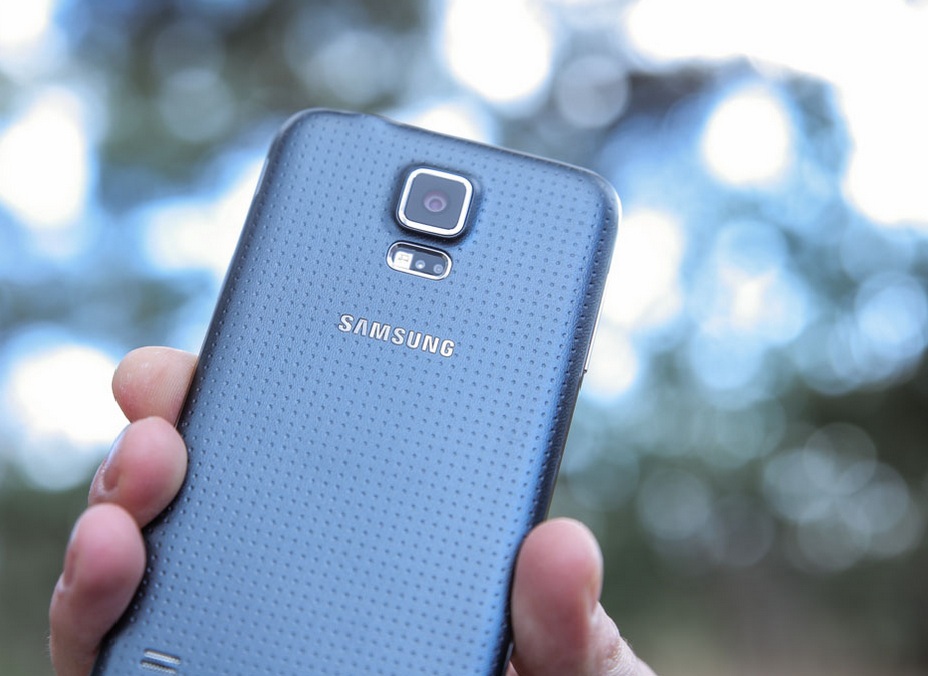
The camera resolution is 16 megapixels instead of 14 megapixels, as was the case with fourth-generation smartphones. In this model of the gadget, the shooting resolution is increased, but the pixel size remains unchanged at 1.12 microns and the standard frame, which has a ratio of 16: 9 (2988 x 5312).
When converted to 35 mm film, the focal length of the lens is 31 mm. Manufacturers have achieved the maximum aperture opening, which is now f / 2.2. The camera interface has been changed, but only in the settings.
The developers have reduced the number of shooting modes and at the same time highlighted the most demanded modes. Additionally, you can download the modes yourself from the World Wide Web.
The camera parameters are listed in the table in the form of a grid. It contains a lot of icons, but this does not cause any particular difficulty in use, since the settings here are understandable, besides, there are useful tips.

It is possible to replace icons in places, they can be placed on the panel on the left, in the main interface of the camera. For users who like to send postcards with small selfies, there is a "Dual Camera" mode, with which you can insert a small picture from the front lens into the main frame.
Built-in camera in Galaxy smartphone S5 gives high quality shooting, but there is very high saturation. This problem can be solved by adjusting the camera settings. Sometimes, of course, it "throws" the saturation unnecessarily, but this can be adjusted in the settings.
In poor lighting conditions, the result for a smartphone is also quite good. The Samsung Galaxy S5 has a front-facing camera with a resolution of 2 megapixels. It shoots worse than the main camera. In the dark, the camera cannot cope.
Operation speed, memory, energy consumption
The Samsung Galaxy S5 comes in several versions. Two of them are most widespread. They are SM-G900F as well as SM-G900H. The first modification is developed on a quad-core Qualcomm processor Snapdragon 801 and supports LTE. It was demonstrated at MWC 2014.

The second modification, which will appear in the near future, is based on an eight-core chip Samsung Exynos 5422. LTE is also available here, only due to the external Intel XMM 7160 module.
In addition to these two versions, there are also several Korean and even Chinese, such as SM-G9006V, G9008V and G9009D. They have DualSIM support. The SM-G900H comes with Samsung's Exynos 5422 chip, which is a beefed-up version of the Exynos 5420 that was used in the Galaxy Note 3.
The Exynos 5420 can be equipped with an Intel XMM 7160 4G module, so LTE works in all Galaxy S5s, but the manufacturer may turn it off or ship mobile phones without it.
The amount of RAM of the gadget is 2 GB, which is not enough for the present time. The Galaxy S5 comes with only 16GB or 32GB of storage. Mobile phone Supports microSD memory card up to 128GB.
![]()
The mobile phone is equipped with a reinforced, removable Li-ion battery with a capacity of 2800 mAh. The battery has a built-in NFC antenna, which is necessary for the phone to communicate with devices that support this data exchange technology. The battery charge, with active use of the gadget, lasts for about 9-12 hours.

Now about the most interesting - appeared new regime Ultra Power Saving, the principle of which is a black and white image on the screen, but at the same time you can make calls and send SMS, turning off the Internet network.
The new power saving mode allows the user to recharge the phone battery much less frequently. It should also be noted that with 10% of the remaining energy, the smartphone can work for a whole day.
Equipment
In the branded box from the Samsung Galaxy S5 smartphone, you will find the smartphone itself, headphones with a remote control and a microphone, Charger with detachable USB cable and instruction manual.

Samsung Galaxy S5 smartphone review
Detailed testing of one of the most anticipated smartphones of the new season
Of course, one of the most long-awaited and anticipated new products among mobile devices of the coming year is the next update of the flagship line. Samsung smartphones- Galaxy S5. The novelty does not need a special introduction - in recent years, the Korean company Samsung Electronics has managed not only to become scandalously famous due to countless litigations with the competing American Apple, but also to occupy one of the leading places in the world market for the sale of tablets, and, of course , smartphones.
Left to right: Samsung Galaxy Note 3, Galaxy S5, Galaxy S4, Apple iPhone 5s

By the way, the Koreans in recent years have firmly taught users that Samsung always has two flagship smartphones on the market at the same time. They are representatives of two top product lines moving in parallel courses - Galaxy Note and Galaxy S. Not so long ago, another update of the tablet phone line happened - the Samsung Note 3 smartphone, about which we wrote so much, went on sale. Now the turn has come to update a series of smartphones with a more "civilized" design.
Samsung Galaxy S5 and Galaxy S4
 |
 |
Smartphones Galaxy series S have always been very different from their semi-tablet counterparts from the Note line precisely in size - they were quite elegant in size devices. However, with the release of the Galaxy S5, it must be admitted that the distance separating them is shrinking more and more. And not only the size of each next representative Galaxy line S are getting bigger, but in the Note line they are gradually decreasing. The Galaxy Note 3 has become the smallest among its brothers, while the Galaxy S5, on the contrary, has acquired such large dimensions that it is time to think about: what, in fact, is the difference between the modern representatives of the two lines? Their performance is absolutely the same, the design is similar, the price is the same, and we have already mentioned the dimensions. Is it really all the difference now lies only in the presence or absence of an electronic pen?
Samsung Galaxy S5 and Galaxy Note 3

In any case, you should not expect a special technological breakthrough from the new flagship of the Galaxy S line. New technological discoveries have not yet been made, but everything that has been discovered has already been implemented, and now they are finishing, finishing, polishing - improving functionality. And it's not just about Samsung devices - the whole market is now waiting for something new. This, by the way, is clearly seen in the example of the last two world IT exhibitions, which took place at the beginning of the year in Las Vegas and Barcelona. The products of the Korean company are no exception: hardware and technical new flagship not much different from the previous one (Samsung Galaxy S4) - now the focus is on improving functionality. Ultra-fast data transfer capabilities, an updated camera control interface, a wide range of fitness apps, a heart rate monitor, a fingerprint reader, and agreements with the world's leading content and service providers to pre-install a variety of applications with a long-term prepaid subscription - that's it. , which is now working at Samsung. Gigabytes and gigahertz somehow suddenly faded into the background, which is probably for the best. Surprisingly, the Koreans did not even add RAM to their new flagship - the Galaxy S5 still has 2 GB of RAM, although the new item still has some changes in hardware.
Main characteristics of Samsung Galaxy S5 (model SM-G900F)
| Samsung Galaxy S5 | LG G2 | TCL Idol X + | Lenovo Vibe Z (K910) | Samsung Galaxy Note 3 (N9005) | |
| Screen | 5.1 ″, Super AMOLED | 5.2 ″, IPS | 5 ″, IPS | 5.5 ″, IPS | 5.7 ″ Super AMOLED |
| Permission | 1920 × 1080, 432 ppi | 1920 × 1080, 424 ppi | 1920 × 1080, 440 ppi | 1920 × 1080, 400 ppi | 1920 × 1080, 386 ppi |
| SoC | Qualcomm Snapdragon 801 (4-core Krait 400) @ 2.5 GHz | MediaTek MT6592 (8 cores ARM Cortex-A7) @ 2.0 GHz | Qualcomm Snapdragon 800 (Quad Core Krait 400) @ 2.2 GHz | Qualcomm Snapdragon 800 (Quad Core Krait 400) @ 2.2 GHz | |
| GPU | Adreno 330 | Adreno 330 | Mali 450MP4 | Adreno 330 | Adreno 330 |
| RAM | 2 GB | 2 GB | 2 GB | 2 GB | 3 GB |
| Flash memory | 16 GB | 16/32 GB | 16 GB | 16 GB | 16-64 GB |
| Memory card support | microSD | — | — | — | microSD |
| Operating system | Google android 4.4 | Google Android 4.2 | Google Android 4.2 | Google Android 4.2 | Google Android 4.3 |
| Battery | removable, 2800 mAh | non-removable, 3000 mAh | non-removable, 2500 mAh | non-removable, 3050 mAh | removable, 3200 mAh |
| Cameras | rear (16 Mp; 4K video), front (2 Mp) | rear (13 Mp; video 1080p), front (2 Mp) | rear (13 Mp; video 1080p), front (5 Mp, video 1080p) | rear (13 Mp; video 4K), front (2 Mp, video 1080p) | |
| Dimensions (edit) | 142 x 73 x 8.1 mm, 145 g | 139 x 71 x 8.9mm, 143g | 140 x 69 x 7.9 mm, 120 g | 149 x 77 x 7.9mm, 147g | 151 x 79 x 8.3mm, 168g |
| average price | T-10725078 | T-10505130 | T-10632117 | T-10516952 | T-10545574 |
| Samsung Galaxy S5 offers | L-10725078-10 | ||||
- SoC Qualcomm Snapdragon 801 (MSM8974AC), 4 cores Krait 400, 2.5 GHz
- GPU Adreno 330, 578 MHz
- Operating room Android system 4.4.2 Kitkat
- Touch display Super AMOLED, 5.1 ″, 1920 × 1080, 432 ppi
- RAM(RAM) 2 GB, internal memory 16 GB
- Support for microSD memory cards up to 128 GB
- 2G, 3G, 4G networks (LTE Cat.4, up to 150/50 Mbps)
- Bluetooth 4.0 BLE / ANT +
- USB 3.0, OTG, MHL
- Wi-Fi 802.11a / b / g / n / ac HT80, MIMO (2 × 2), Wi-Fi hotspot
- NFC, infrared
- GPS (A-GPS), Glonass
- Camera 16 MP, autofocus, LED flash, video UHD (4K) 30 frames / s
- Camera 2 MP (front)
- Accelerometer, gyroscope, distance sensor, compass, barometer, Hall sensor (magnetic field), light, gesture (infrared), fingerprint sensor, heart rate sensor
- Dust and moisture protection according to IP67 standard
- Li-ion battery 2800 mAh
- Dimensions 142 x 72.5 x 8.1 mm
- Weight 145 g
Appearance and usability
As already mentioned, the new model of the Galaxy S series has become significantly larger in size than the previous one. It feels like the smartphone has finally crossed that invisible line called "a little more, and there will be too much": now the device has become really bulky and surprisingly heavy. For the breast pocket of a shirt, for example, this is now certainly an inaccessible guest, although, of course, people who have firmly decided to follow the path of life with a "shovel" at the ready, in size new Galaxy S will not feel anything out of the ordinary. It is still smaller than the Galaxy Note 3, although the difference is already minimal. And nevertheless, it is still not clear why it was necessary to do with practically identical screens new model so much more than the previous one. In the Galaxy S4, the side frames, for example, are only 3 mm wide, while in the Galaxy S5 they suddenly grew to 4 mm, the same goes for the upper and lower parts of the frame - they also suddenly became much wider, although the screen itself is practically not in size has changed.

Concerning appearance, then here the developers clearly adhere to a single design line: metal and leather, leather and metal - they are now used in all mobile devices companies (including numerous wearable gadgets). The only pity is that with the sky-high prices at which the current flagships are sold, the company was greedy to provide real leather - maybe then these devices would look really stylish. But no, as in previous times, ordinary molded plastic is used here to create the appearance that the back of the smartphone is made of leather. Texturing on plastic differs from that of the Galaxy Note 3: here they used a kind of pseudo-embossing, as if a pattern of numerous dots was squeezed out of the skin. Looks nice and fresh, at least better than the glossy plastic that has long adorned the surfaces of all Galaxy S and Galaxy Note.

As for the metal, it is not here either: the shiny "chrome" bezel along the entire perimeter of the case (exactly the same as in the previous models, only with a different pattern) is a sputtering on plastic, not real metal. This bezel, by the way, also became much wider and even thicker, adding weight to the smartphone as a whole.

The surface of the rim is quite slippery - due to it, as well as due to the considerable mass, it is rather inconvenient to lift the device from the table surface, since the fingers do not feel a confident grip.

The back cover can be easily removed from the case and just as easy to put on - it is traditionally fixed on several plastic latches, there is a barely noticeable ledge for engaging with a fingernail. Under the cover, there are slots for a SIM-card and a memory card, located in a "sandwich" one above the other.

Below we arranged a compartment for a removable battery - it supports cards, but the memory card can still be replaced with a hot one. The device uses only one SIM-card, Micro-SIM format, microSD memory card here can be used with a capacity of up to 128 GB.

In the back of the smartphone there is a square window of the camera module, it is quite large in size, next to it there is an LED flash. Below in the recess are the eyes of the sensor for measuring the pulse. The heart rate sensor camera is recessed into the body, and it also has its own backlight - a small LED element illuminates the vessels of the finger attached to the camera, while it counts the heartbeats. Even below there is a hole for sound output from the calling speaker with a slightly curved rod outward, and all this is decorated with a silver chrome logo of the company.
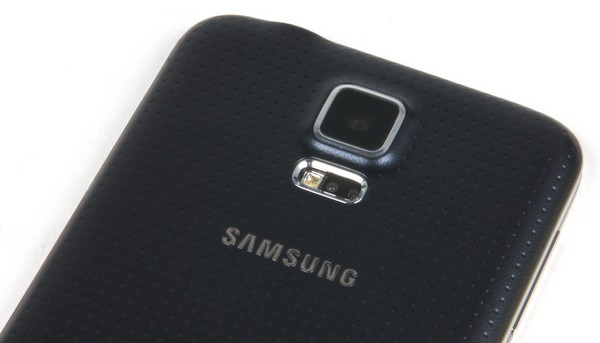
The front panel has not undergone significant changes - it is a completely recognizable element of all Samsung mobile devices. It stands out, first of all, for its elongated mechanical key under the screen, which this time has received additional functionality. This button is also responsible for scanning a fingerprint - now no one can blame Koreans for not having a golden smartphone with a fingerprint scanner. Unlike the iPhone scanner, here you can't just put your finger: you need to slide it along the key, and even at the right speed - if you hurry, you can fail. In this regard, the iPhone scanner looks preferable: not only you do not need to move your finger, but you can also put your finger on the button at any angle, which allows you to hold the device with any convenient grip. In the case of Samsung scanner The Galaxy S5 will have to hold the device with one hand and slide the other over the sensor, which is quite tedious, and most users will most likely simply turn off this feature.

The touch buttons next to the mechanical buttons have a bright white backlight with customizable lighting times, which is commendable. Above, above the screen, you can see a longitudinal cut in the protective glass for sound output from the earpiece, next to it you can see the eyes front camera and sensors. There is also an LED notification indicator, which shines in different colors depending on the charging status and incoming events - its functions can be configured: disabled or activated separately.

There are two buttons on the side faces of the device: on the left - volume control, on the right - on and off. The large metallized keys of all Samsung smartphones have a soft stroke and a distinct pressure, they are perfectly located blindly, and in general, in this regard, the products of the Korean company are one of the best on the market.
At the top, one comfortably located next to one another a headphone jack (3.5 mm) and an infrared transmitter eye, which serves to control various equipment as a remote control. The corresponding proprietary software called Smart Remote moves from model to model - of course, it is also available here. The functionality of the Smart Remote program is at its best: it is not only able to connect a smartphone using an infrared port with any equipment, but also can act as an interactive program guide.

At the bottom, the USB 3.0 connector is covered with a metallized cover with a rubber gasket - it protects the smartphone from dust and moisture getting inside. Yes, yes, the new flagship of the Galaxy S line has finally got IP67 dust and moisture protection. In principle, the previous model also had it, but there it was a separate branch of the line called Galaxy Active... The protection in the Galaxy S5 is arranged in the same way as there: a rubber seal is glued to the inner surface of the back cover, and the connectors are closed with special plugs. It's nice that every time you put it on back cover or the plug is removed from the Micro-USB connector, the smartphone itself reminds you to close the protective covers (the reminder can be turned off).

And finally - about the most pleasant: now a new color has appeared in the arsenal of the Galaxy S line - golden. In addition to it, there are three more colors on sale that have already adorned Samsung's flagship devices (for example, the Galaxy S3). Traditionally, they have been given romantic names: Charcoal Black (Black), Sparkling White (White), Electric Blue (Light Blue), and Copper Gold (Golden). For additional decorations, in particular a key chain or a strap, no fasteners are provided.

Screen
The Samsung Galaxy S5 smartphone is equipped with a Super AMOLED sensor matrix. The screen dimensions are 63 × 113 mm, the diagonal is 5.1 inches, the resolution is 1920 × 1080 pixels. Such a parameter as the density of pixels per inch is here equal to 432 ppi - the density of pixels is very high.
Outside the screen is covered protective glass... The thickness of the side bezels from the edge of the screen to the edge of the body is about 4 mm, the bezels are not very narrow, they were smaller in the previous model.
The brightness of the display can be adjusted manually, or you can use automatic adjustment. The multitouch technology here allows you to process up to 10 simultaneous touches. The screen can be operated with gloved hands, and at the same time it becomes more sensitive to any touch, so in the settings prudently left the option to disable this function. The smartphone also has a proximity sensor that locks the screen when the smartphone is brought to the ear.
 |
 |
Detailed expertise using measuring instruments conducted by the editor of the sections "Monitors" and "Projectors and TV" Alexey Kudryavtsev. Here is his expert opinion on the screen of the test sample.
The front surface of the screen is made in the form of a glass plate with a mirror-smooth surface, resistant to scratches. Judging by the brightness of the reflected objects, there is a very effective antiglare filter, surpassing the Google Nexus 7 (2013) (hereinafter simply the Nexus 7) screen filter in terms of reducing the brightness of reflection. For clarity, here is a photo in which a white surface is reflected in the turned off screens (on the left - Nexus 7, on the right - Samsung Galaxy S5, then they can be distinguished by their size):

Due to the slight difference in the color tone of the reflection and borders, it is difficult to visually assess the amount of decrease in the brightness of the reflection, however, statistics from the graphics editor show that the screen of the S5 is indeed slightly darker than that of the Nexus 7. The doubling of reflected objects is very weak, this indicates that there is no air gap between the layers of the screen. On the outer surface of the screen there is a special oleophobic (grease-repellent) coating (very effective, maybe a little better than on Google Nexus 7), so fingerprints are removed much easier, and appear at a slower speed than in the case of ordinary glass.
When the white field was displayed in full screen and with manual brightness control, its maximum value was 340 cd / m², the minimum was 2 cd / m². Despite the not the highest brightness value, even in bright daylight, the smartphone can be used, since an effective anti-glare filter helps out. You also need to take into account the fact that in this case the smaller the white area on the screen, the lighter it is, that is, the actual maximum brightness of the white areas will almost always be higher than the specified value. For example, when displaying white on half of the screen, the maximum brightness when manually adjusted increases to 360 cd / m². The low brightness mode allows you to use your smartphone without any problems even in complete darkness. Automatic brightness control works according to the light sensor (it is located to the right of the front speaker). You can make adjustments to the operation of this function by moving the setting slider from −5 before +5 units. Further, for three conditions, we give the screen brightness values for three values of this setting - for −5 , 0 and +5 ... In complete darkness in automatic mode, the brightness decreases to 4, 9 and 16 cd / m2, respectively (generally a bit dark), in an office illuminated with artificial light (about 400 lux), the brightness is set to 100, 180 and 270 cd / m2 (acceptable ), in a brightly lit environment (corresponds to lighting on a clear day outdoors, but without direct sunlight - 20,000 lux or slightly more) - increases to 420-425 cd / m2 for all three correction values, which is more than the maximum with manual adjustment and should be enough to ensure readability in the sun. In principle, the result of this function is as expected. When the brightness decreases, modulation appears with a frequency of 240 Hz. The figure below shows the dependence of brightness (vertical axis) on time (horizontal axis) for three values of brightness adjustment:

It can be seen that at maximum brightness, modulation is practically absent (the amplitude is insufficient for visual discernibility of flicker), but at medium and low brightness, the relative amplitude of modulation is high, therefore, image flickering can be seen in the test for the presence of a stroboscopic effect or simply with fast eye movement. Depending on individual sensitivity, such flickering can cause increased fatigue.
This smartphone uses a Super AMOLED matrix - an active matrix based on organic light-emitting diodes. A full color image is created with subpixels of three colors - red (R), green (G), and blue (B), but there are twice as many green subpixels, which can be referred to as RGBG. This is confirmed by a fragment of a micrograph:

(For comparison, you can see the gallery of photomicrographs of screens used in mobile technology.)
For such matrices, Samsung introduced the name PenTile RGBG... The manufacturer calculates the screen resolution for green subpixels, for the other two it will be two times lower. The location and shape of the subpixels in this variant is the same as in the case of the Samsung Galaxy S4 screen. This version of PenTile RGBG is better than the old one with red squares, blue rectangles and green subpixel stripes. Nevertheless, some uneven contrast borders and other artifacts are still present. For example, when displaying a black-and-white world through one pixel (the original can be taken from here) vertical lines they look uneven, and horizontal ones are low-contrast and are separated not by white, but by a greenish gap. Fragment (the link is available original photo) macro photography reveals the cause:

It can be seen that the vertical lines have a black gap and the fact that the sum of the colors of the subpixels can be considered white, but due to the red subpixels on one side, there is some unevenness in the lines. When horizontal lines there is no white gap (there are green subpixels), no black (there are red and blue subpixels). However, these artifacts are of purely academic interest, since under conditions mobile use it is extremely difficult to visually distinguish such small details. As a result, the resolution margin levels out the "peculiarities" of the PenTile RGBG matrix.
The screen is characterized by excellent viewing angles, although white when deflected at relatively large angles takes on a slight tint, but black is just black at all angles (although reflection from bright objects has a bluish halo more elongated horizontally, which is why there are black areas in the light may slightly lighten and acquire a "metallic" tint). So black that the contrast setting is simply not applicable in this case. When viewed from a perpendicular view, the uniformity of the white field is excellent. For comparison, we present photographs in which on Samsung screens Galaxy S5 and the second competitor display the same images, with the screen brightness set to approximately 210 cd / m². White field perpendicular to screens:

Excellent uniformity of brightness and color tone of the white field can be noted. And the test picture (in the Standard):

The color rendition is clearly good, but with all the conventionality of the forced color balance in the camera, set at 6500 K, it can be seen that the colors of the S5 are clearly "colder" and have too much high saturation... Now at an angle of approximately 45 degrees to the plane and to the side of the screen. White box:
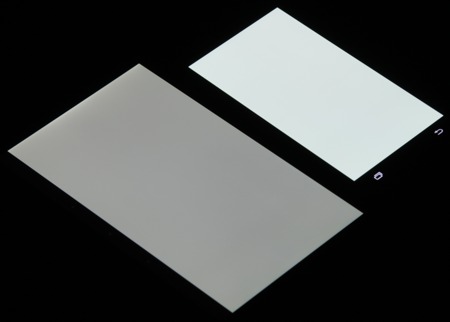
The brightness at an angle on both screens has noticeably decreased (to avoid severe darkening, the shutter speed is doubled in comparison with the previous two photos), but in the case of Samsung, the drop in brightness is much less pronounced. And the test picture:

It can be seen that the colors did not "float" on all screens and the brightness of the Samsung S5 at an angle is noticeably higher.
Switching the state of the matrix elements is performed almost instantly, but on the on (and less often off) front there may be a step (or two) with a width of 16.7 ms (corresponds to a screen refresh rate of 60 Hz). For example, this is how the dependence of brightness on time looks like when switching from black to a shade of 25% (by the numerical value of the color) and vice versa:

In some conditions, the presence of such a step can lead to trails trailing behind moving objects, but in normal use it is almost impossible to see these artifacts. Quite the opposite - dynamic scenes in films on OLED screens are distinguished by high definition and even some "jerky" movements.
The ability to adjust the color rendition is implemented on the page with a choice of profiles, one of which implies some kind of automatic adjustment (profile Adapt Display):

In case one of the three fixed profiles is selected, except for the profile Dynamic, plotted using 32 points with equal intervals by the numerical value of the shade of gray, the gamma curve did not reveal any blockage either in highlights or shadows, and the exponent of the approximating power function is 2.28-2.30, which is slightly higher than the standard value of 2.2 , while the real gamma curve practically does not deviate from the power dependence:

For profile Dynamic The gamma curve has a slightly S-shaped character, which increases the visible contrast of the image. Recall that in the case of OLED screens, the brightness of image fragments dynamically changes in accordance with the nature of the displayed image - it decreases for light images in general and increases for dark ones. As a result, the resulting dependence of brightness on hue (gamma curve), most likely, does not correspond to the gamma curve a little. static image, since the measurements were carried out with sequential output of shades of gray almost on the entire screen. This dynamic picture is enhanced when the option is selected. Auto tuning. screen brightness... Below are the dependences of brightness on time, obtained when switching from black to white and vice versa with the option turned off and on. Auto tuning. screen brightness:

In the second case, the brightness begins to decrease after some time. The picture is slightly darkened, but the energy is saved a little.
Color gamut in case of profiles Dynamic, Standard and Professional photography very wide and almost covers Adobe RGB coverage:

When choosing a profile Cinema the coverage shrinks to the sRGB borders, but still remains a little wider:

Without correction, the spectra of the components are very well separated:

In case of a profile Cinema with maximum correction, the color components are already slightly mixed with each other:

Note that on screens with a wide gamut, the colors of conventional images optimized for sRGB devices appear unnaturally saturated. This can be seen in the above photos. However, a visual assessment showed that when choosing a profile Cinema saturation is noticeably reduced and colors are brought closer to natural. The screenshot after selecting this profile is shown below:

Unfortunately, the most recognizable shades - skin, for example - are still slightly oversaturated.
The grayscale balance is imperfect, but generally acceptable. Color temperature in profiles Dynamic and Standard significantly higher than 6500 K, in the other two it is close to 6500 K, while this parameter does not change very much on the gray scale from white to dark dark gray. The deviation from the blackbody spectrum (ΔE) for most of the gray scale remains below 10 units, which is considered a good indicator for a consumer device, and also changes slightly:


(The darkest areas of the gray scale in most cases can be ignored, since there the color balance does not have of great importance, and the error in measuring color characteristics at low brightness is large.)
To summarize: the screen has a fairly high maximum brightness and a very effective anti-glare filter, so the smartphone can be used outdoors without any problems even on a sunny summer day. In complete darkness, the brightness can be lowered to a comfortable value. Acceptable, but in bright light - it is even recommended to use the mode with automatic brightness adjustment, which works more or less adequately. The advantages of the screen include a very good oleophobic coating and a color balance close to standard (when choosing the appropriate profiles). At the same time, let us recall the general advantages of OLED screens: true black color, excellent uniformity of the white field, less than that of LCDs, a drop in image brightness when viewed from an angle. The disadvantages include the modulation of the screen brightness, which appears at medium and low brightness values. Users who are particularly sensitive to flicker may experience increased fatigue due to this. However, the overall quality of the screen is very high.
Sound
In sound terms, the smartphone is about the same as the Galaxy S4. The sound is moderately bass, low frequencies not deprived, clean in the entire range, but not so loud - there were also louder devices (HTC One or Oppo Find 5, for example). The grille for sound output is cut into the rear wall here, so the sound is muffled when the device is on the table. In the conversational dynamics, the voice of a familiar interlocutor, timbre and intonation remain recognizable, making telephone conversations on the Samsung Galaxy S5 is quite comfortable.
The handset offers a choice of three pre-installed players to play music tracks: Google play Music, Yandex.Music and Samsung's own player. All sound effects when playing tunes with a proprietary player are united by a technology called SoundAlive - although some of them are available only with headphones connected. The same goes for the sound optimization function. There are a lot of various virtual effects, they are combined here in a matrix of squares, you can experiment for a very long time.
 |
 |
Camera
Samsung Galaxy S5 is equipped with two digital camera modules with a resolution of 16 and 2 megapixels. The front one takes pictures with a maximum resolution of 1920 × 1080, and it also shoots video with the same resolution.

The main rear camera is equipped with a new 16-megapixel module with ultra-fast autofocus (focusing in 0.3 s), stabilization, one-section LED flash and the ability to shoot videos in UHD resolution (4K). In addition to one fashionable feature - 4K video recording - another one is used here: as in the newest Sony Xperia Z2, there is a selective focusing option that allows you to highlight a certain part of the image, leaving the background blurred. That is, now you no longer need to use special lenses and lenses to create a shallow depth of field (DOF) effect.
When shooting in automatic mode, which is set by default, photos are taken at 5312 × 2988. I really liked the design and organization of the new camera control interface. Here, as in the case of the audio settings menu, everything is divided into equivalent cells, each of which is always in sight, interactive, their drawing is distinct, the entire menu is perfectly visible even in the brightest sunlight. In general, the settings menu for camera control turned out to be the best on the market in terms of ease of access to all functions and overall clarity.
 |
 |
 |
 |
 |
 |
The camera can shoot video in UHD (4K) resolution, there are several resolutions to choose from, up to a maximum of 3840 × 2160. In the settings, traditionally for the latest top models of the mobile market, there are also slow-motion and fast-motion modes. Examples of test videos are presented below.
- Movie # 1 (189 MB, 3840 × 2160, 4K)
- Movie # 2 (58 MB, 1920 × 1080, 1080p)
- Movie # 3 (123 MB, 3840 × 2160, 4K indoors)
- Movie # 4 (71 MB, 1280 × 720, slow motion)
- Movie # 5 (4 MB, 1920 × 1080, accelerated)
Examples of photos with our comments are presented below.
 |
The image sharpness is good. |
 |
Sharpness is also good across the frame. |
 |
Small details are worked out well enough. |
 |
The camera does not do so well in backlighting, but the exposure is good. |
 |
On thin lines, you can see small waves from the noise reduction - but only on closer inspection. |
 |
In low light, noise can be discerned - however, relatively small. |
 |
The camera handles noise in the shadows well. True, the detailing suffers a little from this. |
 |
Macro in low light the camera manages well, but it is worth using the stop because of the relatively long shutter speeds. |
 |
At good lighting macro photography is good for the camera. |
 |
Another example of a good macro. |
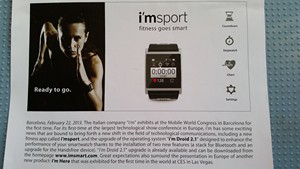 |
The text is well done, but slightly damaged. However, it is possible that the camera works more accurately with smaller text. |
Panorama stitching is almost perfect. Only dynamic objects suffer, which is quite natural. |
 |
Illumination ≈1300 lux. The camera is doing very well. |
 |
Illumination ≈460 lux. The situation remains practically unchanged. |
 |
Illumination ≈240 lux. Noises become noticeable, especially their processing. |
 |
Illumination ≈240 lux, flash. The flash noticeably improves the situation, almost returning the original resolution. |
 |
Lighting<1 люкс. В темноте камера не справляется. |
 |
Lighting<1 люкс, вспышка. И в темноте вспышка отрабатывает очень хорошо. |

First of all, it is worth noting that now the camera has a 1 / 2.6 ″ sensor, and not just a higher resolution, while earlier smartphone cameras were awarded only 1/3 ″ matrixes (not counting Nokia), or even less. until Sony decided to install a 1 / 2.3 ″ sensor in the Xperia Z1. So Samsung, following Sony, began a slow but steady movement towards improving image quality. And, I must say, the result is already visible to an inquisitive eye.
First of all, you can already see good work with noise. Their processing still leaves much to be desired, but if you do not look at the images pixel by pixel, then noticeable strong color noise in the shadows is practically not visible. Of course, this is the result of the noise reduction, but the higher resolution allows it to work more subtly, and the increased size of the sensor slightly reduces the likelihood of strong noise. Of course, we will not indulge in arguments about the size of the pixel (similar to HTC) and the supposedly resulting qualities of the camera, but the increase in the sensor definitely bears fruit. Secondly, the image detail has improved, which is also the merit of a higher resolution and an enlarged sensor.
I would like Samsung to improve the noise reduction, then the camera can already be compared with ordinary compacts. Although even without this, she shows herself very worthily, and it is clear that they have worked hard on her. The camera optics work fairly smoothly across the entire field of the frame and on all shots. Of course, it would be strange to see flaws in the flagship in such places, but we have already encountered this. Sharping can only be found if you know where to look. The only thing that really cannot be called ideal is the work of the noise control - such a processing result looks very archaic in the images of a modern flagship.
Based on the results of shooting the stand, we can conclude that the actual resolution of the images is probably not the highest, but we have already mentioned that in this case this is far from the main characteristic, especially in the vicinity of such values, since the resolution can be high, but at the same time not quite natural. Nevertheless, the camera resolution is quite decent. It is also worth noting the good work of the flash, and the sensor, which works out quite stably in different lighting conditions.
In general, the camera is made very decently, almost at the level of compact cameras. Of course, it also has something to work on, and in general there is much to strive for. But even in its current form, it is well suited for shooting documentary and fictional subjects.
Telephone part and communications
The developers put special emphasis on the communication capabilities of the Samsung Galaxy S5: the smartphone works in the fifth generation of Wi-Fi 802.11ac networks with support for 2 × 2 MIMO mode - in this mode, data can be received and transmitted in two streams, that is, up to two times faster than in the first generations of 802.11ac compliant devices. In addition, the device provides support for a large number of 4G (LTE) frequencies and speeds corresponding to the LTE Category 4 standard - up to 150 Mbps. With the SIM-card of the domestic operator Megafon, the smartphone in practice confidently finds and works with the LTE network.
In addition, the smartphone has support for the 5 GHz Wi-Fi range and the NFC standard. As a standard, you can organize a wireless access point via Wi-Fi or Bluetooth channels, there is a Wi-Fi Direct mode. The navigation module works with both the GPS system (with A-GPS) and the domestic Glonass. The speed and quality of the GPS module does not give rise to any complaints: the system works quickly, reliably, the navigation module finds the first satellites almost instantly, and even indoors.
 |
 |
Spontaneous reboots / shutdowns were not observed during testing. The screen of the smartphone is large, so the drawing of letters and numbers of virtual keyboards is quite comfortable to control. It is very convenient that there is a dedicated top row with numbers - you don't have to switch the layout every time. But the layout itself and the arrangement of the keys are not the same as those of others: instead of just pressing the dedicated button with the globe, here you have to switch language layouts by side scrolling with the spacebar, which is certainly less convenient. The phone application supports Smart Dial, that is, when dialing a phone number, a search is immediately carried out by the first letters in contacts. Support for continuous writing by sliding is here, but the ability to move the keyboard closer to one of the edges, as on the Galaxy Note series tablet phones, is not here.
 |
 |
OS and software
The system uses the Google Android software platform of the latest version 4.4.2 (Kitkat) and the proprietary graphic user interface TouchWiz, the appearance of which has undergone changes. He became, according to the new fashion, more "flat", which obviously did him good, although the traditional Asian luridness remained. The appearance of the settings menu has changed: now all icons have the appearance of absolutely identical circles and they are located in the form of a single long list. But, of course, the display of the menu can be changed, bringing it to the old view with vertical tabs. In this case, there will be no longer four of them, as before, but as many as six. In general, I liked the new look of the interface and the settings menu more than the old one: everything is combed, ordered, symmetrical, working with various subsections of the menu has become more intuitive. The menu of installed applications has not undergone significant changes, but now you can display a special button on the home screen, clicking on which opens a context menu with quick access to the most popular applications. The notification menu has received two additional dedicated oval buttons to quickly navigate to the search throughout the smartphone and enable quick connection to familiar devices.
 |
 |
 |
 |
 |
 |
 |
 |
The shell is full of all sorts of tricks for one-handed control, support for contactless and contact gestures, and even with the help of the eyes. Most of these features are already familiar to users of top-end devices of the Korean company, but now there are also added gestures for communicating with smart watches and other wearable gadgets, the range of which Samsung continues to expand.
 |
 |
 |
 |
 |
 |
Another one has now been added to the various ways of locking the smartphone: you can lock the screen using your fingerprint, the scanner of which is built into the center key under the screen. To successfully memorize the texture of your fingertip, you need to swipe the sensor at least eight times, after which you will also have to come up with a standard digital code in case your finger remains unrecognized within five attempts. It's a shame when the developer also imposes restrictions on the personal password you create: an attempt to limit yourself to a digital password failed - you need to intersperse numbers with letters.
 |
 |
 |
 |
 |
 |
By the way, the security issue has been strengthened in the Samsung Galaxy S5 with another innovation: now, due to the appearance of the "Kids" mode, you can open access only to certain permitted programs, and then calmly entrust the device for 30 thousand rubles to play the child.
![]()
Since we are already talking about games, it is worth noting that we have tested such games as Dead Trigger 2 and Asphalt 8 on a smartphone - no problems with their playback were found.



Another specific operating mode has been added to the smartphone, which the developers themselves talked about a lot at presentations. In fact, this is the usual power-saving mode that any built-in program for saving energy in mobile devices has, just Samsung brings its smartphone to complete "exhaustion" in this mode. When the maximum power saving mode is activated, not only all network interfaces are turned off, but also the graphical interface of the shell turns black and white, and the number of applications allowed to work is strictly limited. Naturally, in this mode, the smartphone can "work" much longer (who would doubt it), but this work will be carried out in a very limited framework.
 |
 |
One of the central applications pre-installed in modern top-end Samsung smartphones, which developers constantly remind of, is a program for tracking their own health called S Health. The program has a wide range of functions useful for improving health: a pedometer, exercise recording, nutrition control, etc. Now the application not only received the new version of S Health 3.0, but also acquired additional functionality in the form of a dedicated hardware heart rate counter. In principle, some programs used to try to count heartbeats using an ordinary smartphone camera, but now they have allocated a whole block with a small camera and backlight for this. You need to put your finger on the groove in the back of the smartphone, and then the program will count your heart rate. Naturally, this data is saved, processed and displayed in the form of graphs and tips for a healthy lifestyle.

 |
 |
 |
 |
Performance
The hardware platform of the Samsung Galaxy S5 is based on the Qualcomm Snapdragon 801 single-chip quad-core system (SoC). the chip version was limited to 2.36 GHz.
The processor is supported in graphics processing by the same Adreno 330 video accelerator, but an increase in frequencies can be traced here as well: the GPU is already overclocked to 578 MHz instead of 450 MHz. About 12 GB (out of 16) of the device's own memory for the user's needs is initially available, the amount of RAM here is 2 GB - in this regard, surprisingly, no increase has occurred, while Sony has equipped its newest flagship with three gigabytes. random access memory. MicroSD memory cards are supported in this model, you can also connect external flash drives, keyboards and mice using a special adapter in OTG mode.
 |
 |

 |
 |
Since the most powerful and the most productive of the competing serial platforms is now SoC MediaTek MT6592, which is configured with eight full-fledged processor cores [simultaneously] operating at a frequency of up to 2 GHz, it is logical to include its results in the comparison first of all. Recall that recently we released a review of the powerful TCL Idol X + smartphone, the work of which is based on the maximum version of this platform. Also, of course, it is worth adding to the comparison the results demonstrated in the same tests by the previous version of the Qualcomm platform - Snapdragon 800, on which all top smartphones of last year work. However, the most important battle today will still not take place, because the main competitor of the hero of today's review, the flagship smartphone Sony Xperia Z2, also built on the latest Qualcomm Snapdragon 801, has not yet reached our test laboratory. In the near future, we will definitely compare it with the data obtained today from the Samsung Galaxy S5.
To get an idea of the performance of the tested smartphone platform, let's run a standard set of tests.
All the results obtained by us when testing the smartphone in the most recent versions of popular benchmarks, we have summarized for convenience in tables. Several other devices from different segments are usually added to the table, also tested on similar latest versions of benchmarks (this is done only for a visual assessment of the obtained dry numbers). Unfortunately, within the framework of one comparison, it is impossible to present the results from different versions of benchmarks, so many worthy and relevant models remain "behind the scenes" - due to the fact that they once passed the "obstacle course" on previous versions of test programs.
Testing in MobileXPRT, as well as in the latest versions of AnTuTu 4.x and GeekBench 3:
 |
 |
 |
 |
 |
 |
 |
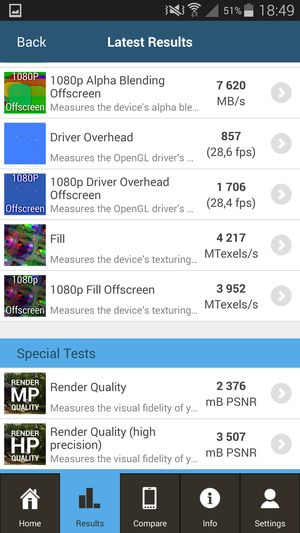 |
The results of testing are as follows. As for the competing MediaTek MT6592, the latest Qualcomm system (Snapdragon 801) coped with it in all respects. In general, this is not surprising at all, given that the previous version of Snapdragon 800 coped with it. As for the comparison with Snapdragon 800, according to the results of all tests, there was practically no real gain: all the same maximum 35K points in AnTuTu, and in other benchmarks the difference is scanty - within the margin of error.
By the way, with regard to these very resulting figures: since the smartphone being tested today is a landmark device, and the rest will be equal to it throughout the year, it is probably worth recalling the fresh alignment of forces. Based on the figures of the popular AnTuTu benchmark, it looks like this: eight MediaTek MT6592 cores with a frequency of 2 GHz demonstrate 31K points in this test (26 thousand points for eight-core Zopo 998 and THL T100S with a lower frequency of processor cores - 1.7 GHz), and about 35 thousand - in top smartphones such as LG G2, Sony Xperia Z1, Acer Liquid S2 and now Samsung Galaxy S5, built on the Qualcomm Snapdragon 800/801 hardware platform. There are two main conclusions drawn from all these comparisons: TCL Idol X + is the first smartphone on the MediaTek platform, which managed to get close to the leading solutions on Qualcomm, albeit due to twice as many processor cores. And the second: the new version of the top-end Qualcomm platform practically did not bring an increase in performance, although this microscopic superiority allowed it to even more firmly gain a foothold on the podium as the undisputed leader among platforms for mobile devices. According to the said, the Samsung Galaxy S5 smartphone on the Qualcomm Snapdragon 801 platform is currently one of the most powerful smartphones on the planet.
Testing the graphics subsystem in the 3DMark cross-platform test:
When testing in 3DMark for the highest performing smartphones, it is now possible to run the application in Unlimited mode, where the rendering resolution is fixed at 720p and VSync is disabled (which can cause the speed to rise above 60 fps).
 |
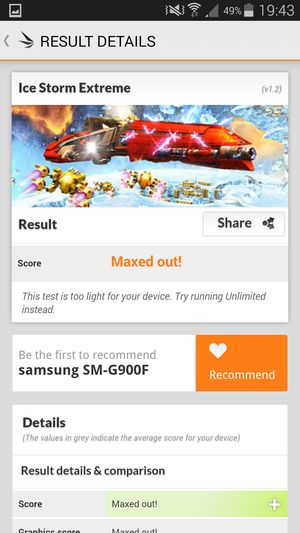 |
 |
The results of testing the graphics subsystem in the gaming test Epic Citadel, as well as Basemark X and Bonsai Benchmark:
The lag in the Mali-450MP4 video subsystem is still noticeable: this video accelerator produces about 47 fps in those test modes in which the Adreno 330 produces 60 fps.
 |
 |
 |
 |
 |
 |
| Samsung Galaxy S5 (Snapdragon 801) |
LG G2 (Snapdragon 800) |
TCL Idol X + (MediaTek MT6592) |
Lenovo Vibe Z (Snapdragon 800) |
Samsung Note 3 N9005 (Snapdragon 800) |
|
| Epic Citadel, High Performance (more is better) |
59.1 fps | 56.7 fps | 47.7 fps | 59.8 fps | 59.1 fps |
| Epic Citadel, High Quality (more is better) | 58.4 fps | 56.3 fps | 46.5 fps | 59.5 fps | 58.8 fps |
| Epic Citadel, Ultra High Quality (more is better) | 52.0 fps | 51.3 fps | no support | 46.7 fps | 50.1 fps |
| Bonsai benchmark | 51.7 fps / 3625 | — | 23.6 fps / 1656 | — | — |
| Basemark X, Medium Quality | 24095 | — | 9808 | — | — |
| Basemark X, High Quality | 11983 | — | 3686 | — | — |
Browser cross-platform tests:
As for benchmarks for evaluating the speed of the javascript engine, you should always make allowances for the fact that the results in them significantly depend on the browser in which they are launched, so that the comparison can be truly correct only in the same OS and browsers, and this possibility is available when testing not always. In the case of Android OS, we always try to use Google Chrome.
 |
 |
Video playback
To test the "omnivorous" video playback (including support for various codecs, containers and special features, such as subtitles), we used the most common formats, which make up the bulk of the content available on the Web. Note that it is important for mobile devices to have support for hardware video decoding at the chip level, since it is often impossible to process modern versions using processor cores alone. Also, do not expect a mobile device to decode everything, since the leadership in flexibility belongs to the PC, and no one is going to challenge it.
With video playback on the Samsung Galaxy S5, things are not as smooth as we would like. Surprisingly, this is one of the rare smartphones in which the popular MX player flatly refuses to start with the Hardware + decoder, and more often than not, this is the only option that saves the situation when the standard player cannot play the audio track of the file. That is, in the case of the Samsung Galaxy S5, in order to normally play three out of five of our test files (MKV), you will have to use a software decoder (at least to decode audio - the video can be decoded by hardware) - neither Hardware nor Hardware + , nor, of course, the standard video player decoder is not capable of playing these common types of files with sound on the network. And this is a clear drawback, because we have a solution with an excellent in all respects a large and high-quality screen and maximum performance, which could become an excellent multimedia assistant. By the way, Galaxy Note 3 also has similar problems - we hope that with the release of updates for MX Player, the situation will somehow change. By the way, top smartphones LG and Sony always have complete order in this plate, because even with their own hardware they are able to play all the files presented, not to mention support for all modes of the MX player.
| Format | Container, video, sound | MX Video Player | Native video player |
| DVDRip | AVI, XviD 720 × 400 2200 Kbps, MP3 + AC3 | reproduced normally | reproduced normally |
| Web-DL SD | AVI, XviD 720 × 400 1400 Kbps, MP3 + AC3 | reproduced normally | reproduced normally |
| Web-DL HD | MKV, H.264 1280 × 720 3000Kbps, AC3 | ||
| BDRip 720p | MKV, H.264 1280 × 720 4000 Kbps, AC3 | plays normally, sound only with software decoder (Hardware + not supported) | video plays fine, no sound¹ |
| BDRip 1080p | MKV, H.264 1920 × 1080 8000Kbps, AC3 | plays normally, sound only with software decoder (Hardware + not supported) | video plays fine, no sound¹ |
¹ the sound in MX Video Player was played only after switching to software decoding (mode Hardware + not supported); the standard player does not have such a setting
 |
 |

Additionally, the MHL interface was tested. To test it, we used an LG IPS237L monitor that supports direct MHL connection using a passive Micro-USB to HDMI adapter cable. Recall that Samsung has implemented its own version of this interface at the physical level. As a result, to connect an external device via MHL, you need to use special adapters or connect standard MHL adapters through simple passive adapters. In this case, we carried out the test using a proprietary Samsung adapter, while the MHL output was carried out at a resolution of 1920 x 1080 pixels with a frequency of 60 fps.
In the portrait orientation of the smartphone, the display of the image on the monitor screen is also carried out in portrait orientation, while the image on the monitor is inscribed in the height of the screen, and wide black fields are displayed on the right and left. In this case, the actual resolution on the monitor screen is, of course, lower than the resolution on the smartphone screen. In landscape orientation of the smartphone, the display of the image on the monitor screen is carried out in landscape orientation, while the image on the monitor is inscribed in the boundaries of the screen and exactly corresponds to the image on the smartphone screen. An exception is the startup screen, which is displayed only in portrait orientation:

The MHL sound is output (in this case, the sounds were heard through the headphones connected to the monitor, since there are no speakers in the monitor itself) and is of good quality. At the same time, at least multimedia sounds are not output through the loudspeaker of the smartphone itself, and the volume is controlled by buttons on the smartphone body. Basically, in the smartphone settings, you can select the sound output mode - stereo or surround. However, in our case, the monitor only received stereo sound, so there was no choice. The smartphone connected via MHL is being charged.
To test the output of video files on the screen of the device itself, we used a set of test files with an arrow and a rectangle moving one division per frame (see "Methodology for testing video playback and display devices. Version 1 (for mobile devices)"). Screenshots with an exposure of 1 s helped to determine the nature of the frame output of video files with various parameters: the resolution varied (1280 by 720 (720p), 1920 by 1080 (1080p) and 3840 by 2160 (4K) pixels) and the frame rate (24, 25, 30, 50 and 60 fps). In our tests, we used the MX Player video player in the Hardware mode, as there were a lot of artifacts in the Hardware + mode. The results of this test (block labeled "Smartphone Screen") are summarized in the table:
| File | Uniformity | Skips |
| Smartphone screen | ||
| 4K / 30p | OK | No |
| 4K / 25p | OK | No |
| 4K / 24p | OK | No |
| 1080 / 60p | Great | No |
| 1080 / 50p | Great | No |
| 1080 / 30p | Great | No |
| 1080 / 25p | Great | No |
| 1080 / 24p | Great | No |
| 720 / 60p | Great | No |
| 720 / 50p | OK | No |
| 720 / 30p | Great | No |
| 720 / 25p | Great | No |
| 720 / 24p | Great | No |
| MHL (monitor output) | ||
| 4K / 30p | Great | No |
| 4K / 25p | OK | No |
| 4K / 24p | Great | No |
| 1080 / 60p | Great | No |
| 1080 / 50p | Great | No |
| 1080 / 30p | Great | No |
| 1080 / 25p | Great | No |
| 1080 / 24p | Great | No |
| 720 / 60p | Great | No |
| 720 / 50p | OK | No |
| 720 / 30p | Great | No |
| 720 / 25p | OK | No |
| 720 / 24p | Great | No |
Note: If both columns Uniformity and Skips green ratings are set, this means that, most likely, when watching movies, artifacts caused by uneven alternation and skipping of frames will either not be visible at all, or their number and visibility will not affect the viewing comfort. Red marks indicate possible problems with the playback of the respective files.
According to the criterion for outputting frames, the quality of video playback on the screen of the smartphone itself is high, since frames (or groups of frames) can be displayed with a more or less uniform alternation of intervals, and there are no frame drops. The smartphone can even display 4K files up to and including 30p. However, the uniform interleaving of frames is a relatively unstable state, since some external and internal background processes lead to periodic failure of the correct interleaving of intervals between frames. When playing video files with a resolution of 1920 by 1080 (1080p) on a smartphone screen, the image of the video file itself is displayed exactly along the edge of the screen, one to one pixel by pixel, that is, in its original resolution (adjusted for some PenTile features). The brightness range displayed on the screen actually corresponds to the standard range of 16-235 - in the shadows only a couple of shades merge with black, but all the shades are displayed in the highlights. However, dark scenes may not look very good, as the darkest shades differ too much in brightness and color tone, which can lead to excessive visibility of compression artifacts.
With a monitor connected via MHL, during video playback with a standard player, the video file is displayed only in landscape orientation, while only the video file is displayed on the monitor, and only information elements and virtual controls are displayed on the smartphone screen.

The results of the tests of output to the monitor are given in the table above in the block "MHL (output to the monitor)". The output quality is very good. When playing video files with a resolution of Full HD (1920 x 1080 pixels) on the monitor screen, the image of the video file itself is displayed exactly on the edge of the screen, maintaining the true proportions, and the resolution corresponds to the Full HD resolution. The brightness range displayed on the monitor is equal to the standard range of 16-235, that is, in the shadows and highlights, all gradations of shades are displayed.
The takeaway is typical: an MHL connection can be used to play games, watch movies, display web pages, and other activities that benefit from the exponential increase in screen size. However, you will have to purchase an adapter specifically for Samsung or find an appropriate adapter.
Battery life
The lithium-ion battery installed in the Samsung Galaxy S5 has a good capacity by modern standards, but not a record 2800 mAh capacity. Accordingly, in terms of battery life, the device showed very good results, which we traditionally summarized in a comparative table.
| Battery capacity | Reading mode | Video mode | 3D Game Mode | |
| Samsung Galaxy S5 | 2800 mAh | 17h 20m | 12h 30m | 4h 30m |
| TCL Idol X + | 2500 mAh | 12h 30m | 7h 20m | 3h 00m |
| Lenovo Vibe Z | 3050 mAh | 11h 45m | 8h 00m | 3h 30m |
| Acer Liquid S2 | 3300 mAh | 16h 40m | 7h 40m | 6h 00m |
| LG G Flex | 3500 mAh | 23h 15m | 13h 30m | 6h 40m |
| LG G2 | 3000 mAh | 20 h 00 m | 12h 30m | 4h 45m |
| Sony Xperia Z1 | 3000 mAh | 11h 45m | 8h 00m | 4h 30m |
| Samsung Note 3 N9005 | 3200 mAh | 22h 30m | 14h 00m | 4h 45m |
Continuous reading in the FBReader program (with a standard, light theme) at the minimum comfortable brightness level (the brightness was set to 100 cd / m2) lasted more than 17 hours until the battery was fully discharged, and when continuously watching YouTube videos in high quality (HQ) with the device lasted 12.5 hours with the same brightness level through the home Wi-Fi network, in 3D games mode the smartphone withstood 4.5 hours worthy for such a screen, and really pleased with such stability: its predecessor Galaxy S4 was at first very overheating and with These tests do not work well, and only with the firmware update the situation returned to normal. With the new flagship, even now, before the start of sales, no problems were found in this regard, and by the way, the device heats up much less than its predecessor.
Outcome
Summing up a Samsung Galaxy S5 review is both easy and difficult. It's easy, because perhaps no one needs to explain to anyone why the flagship smartphones of the Korean company are deservedly among the best on the market. And what makes them stand out is not only the combination of top-end technical characteristics and maximum performance, there is also something else. It seems to us that the company is one of the few who are not ashamed to spy on users' desires. For most manufacturers, this always remains only unfulfilled pretentious slogan promises, and in practice, no matter how much users cry about something, they will never get it. But the Koreans have a completely different point of view on this matter, they readily satisfy any desires of buyers. Want a removable battery? - Get it. Need a memory card slot? - Yes, for God's sake, we do not mind! Suddenly you fell in love with the golden color? - Here, and we now have a golden smartphone. And with such simple actions, coupled with good quality products and huge production volumes, the Korean company managed to climb to the very top of the mountain, pushing many along the way, and simply throwing someone off the cliff. The survivor is the one who knows how to adapt, and this is what Koreans do best.
As for the hero of today's review, here we can say with confidence that he has become a worthy successor to the flagship line. An excellent screen, powerful hardware, full technical completeness, good battery life and maximum functionality, a few added features like a heart rate monitor and a fingerprint scanner are all worthy of praise. Although, it is worth admitting that in the fifth Galaxy S there were not so many notable innovations that one could rightfully call it a completely new model, in terms of design and appearance, so for sure (in this regard, by the way, there was even a kind of decline: the smartphone has become heavier, larger, rougher - everyone admits it). It’s even surprising how the Koreans didn’t call this model Galaxy S4s - such a “letter modifier” that has already become universally recognized, denoting an improved version of the model, would be more appropriate here. But this is all just a little embarrassing.
What's really depressing is how Samsung is pushing the prices of its top-end smartphones. It seems that Koreans no longer even remember that prices can sometimes vary somehow - they got to the 30,000 mark with the previous flagship and now put the same price tag on all subsequent models as a matter of course. The tricky thought in the minds of entrepreneurs, obviously, is this: "For the first time they will complain, but the next time they will be glad that they did not raise the price even higher." So, by the way, it happened: now users are already happy that the price of the new flagship at the start of sales was not raised higher than that of the previous one. This is very alarming, and of course, against this background, it is difficult to recommend such a device for purchase: it is certainly very worthy, but for many, Samsung products may not be affordable right now. Did we think about five years ago that we would talk like that in the future about the products of this Korean company?
In conclusion, we suggest that you familiarize yourself with our video review of the Samsung Galaxy S5:
In contact with
classmates
The iconic smartphone of last year was the Samsung S5, model SM-G900F. This device, although in appearance and strongly resembles its predecessor, but it has a number of significant differences. It is about its capabilities and characteristics that will be discussed further.
Positioning
Originally referred to premium solutions Samsung Galaxy S5 SM-G900F. This is truly a flagship device. Its characteristics and parameters are relevant to this day. Although now a more advanced smartphone has appeared (we are talking about the flagship of 2015 - Samsung S6) from this Korean manufacturer, in terms of hardware and software parameters, the difference between them is not so significant. Therefore, this gadget can still be attributed to the premium segment. At the same time, its cost has significantly decreased over the past time. This nuance makes its purchase even more justified. Moreover, it will serve you for more than one year and will become a faithful assistant in solving various problems, regardless of their level of complexity.
What do we get in the box when we buy?
Although it is the flagship device of the S5, the package bundle is very modest. It includes, in addition to the battery and smartphone, the following:
- Interface cord.
- A quick start guide (it also contains a warranty card).
- Charger.

The case, protective film and memory card will have to be purchased separately for an additional fee. The same statement applies to the speaker system. It's good if you have good headphones. If not, then we buy immediately. And to get good sound, they must have the right quality.
Design
The S4 and S5 of the SM-G900F have a lot in common. Most of the front panel in the S5 is occupied by a 5.1-inch display, which is protected by shock-resistant Gorilla Eye glass. This device uses its third generation. Below the screen is a typical control panel, which consists of 2 touch buttons (located at the edges of the device) and one mechanical (located in the center of the panel). A fingerprint sensor is integrated into the same mechanical button. This innovation is one of the most important differences between the S4 and S5. Above the display are displayed: a front camera, distance sensors, light and gesture sensors, an LED event indicator and an earpiece. On the left is the power button of the device, and on the right is the volume control. On the bottom edge of the "smart" phone there is a hole for the spoken microphone and micro-USB format. Above are located: a port for connecting a stereo headset, a microphone for making a loud conversation. On the back cover of the gadget, there is a main camera, double illumination and a loud speaker. It should also be noted that the degree of protection of the case of this device is IP67. This allows it to be submerged under water to a depth of 0.5 meters and protects against possible dust penetration.
Semiconductor base
Samsung SM-G900F is based on one of the best computing platforms for mobile devices - Snapdragon 801, which is developed by the leading manufacturer of ARM chips - Qualcomm. This processor consists of 4 modified computing cores based on the Krait 400 architecture. All are manufactured using a 28nm manufacturing process and can be overclocked with peak performance up to 2.5 GHz. Now, a year after the start of sales of this gadget, there are still no devices in the middle segment whose performance level would match the computing capabilities of this chip. The Snapdragon 801 can handle almost any task today without any problems. The only thing he will definitely have problems with is new 64-bit applications. All of its main registers can handle only 32 bits per clock cycle. Hence the possible problems with the new software. But so far there are not so many such applications, and the transition process itself is not going so quickly.
Screen
The Samsung Galaxy S5 SM-G900F boasts one of the best displays in its niche. Its diagonal is an impressive 5.1 inches even by today's standards. It is made according to the technology typical for this manufacturer - "SuperAMOLED". Its resolution is 1920x1080. The image on it is displayed in the "FullHD" format. The screen is protected, as noted earlier, by a special third-generation Gorilla Eye shock-resistant glass. The image quality on this screen raises no objections. Individual pixels on it without special devices are almost impossible to distinguish with an ordinary eye.
Graphics Accelerator
The developers did not forget to equip the SM-G900F with a graphics accelerator. Galaxy devices are not always equipped with this component. This device has "Adreno 330" installed. This video card even now belongs to the top-end. If we add to this the relatively low resolution of the display in 1920x1080, then in general there are no problems with the processing of graphic information. This is quite enough for solving the most resource-intensive tasks today. The only problem might be handling new programs that are optimized to run 64-bit applications. They were already developed for the new "hardware" and will definitely not work on this graphics accelerator. So far, there is very little such software, and the process itself, as already mentioned, is rather slow.

Cameras
The highlights of your life can be easily captured digitally with the main camera in the SM-G900F. It is based on a 16 megapixel sensor. There are many modes of its operation at the software level. All this makes it possible to obtain sufficiently high-quality images in almost any situation. There's also an autofocus system and, of course, a dual LED backlight. With video recording, this camera is also doing great. It can record video in 2160 p format with a refresh rate of 30 images per second. There is also the possibility of recording in 1080p, but in this case the number of images will double and amount to 60 frames per second. The sensor of the front camera is more modest - 2 megapixels. This will be enough for making video calls. But the "selfies" obtained with its help will be of average quality.
Memory
The capacity of the integrated storage is identical for all Samsung SM-G900F devices - 16Gb. At the same time, part of it is occupied by pre-installed software, and about 11.5 GB is allocated for the needs of the user. With reasonable use, this should be enough for comfortable work on this device and there will be no shortage of free space. If the built-in Samsung Galaxy SM-G900F 16Gb is not enough for you, then you can increase the amount of memory using an external flash card. The necessary slot is in this device and the maximum capacity of the external storage in this case can reach 128 GB. The RAM in this gadget is 2 GB. Of these, about half (that is, 1 GB) is used immediately by system processes. The rest of the RAM is allocated to the user to run his applications.
The battery of the gadget and its autonomy
The indisputable advantage of the Samsung SM - G900 F is its autonomy. The device is equipped with a removable 2800 mAh battery. We add to this a 5.1-inch screen with a resolution of 1920 × 1080, as well as a productive, but no less energy-efficient processor, and we get 2-3 days of battery life with an average load. If you watch a FullHD video or play a demanding toy, the specified value will be reduced to 12 hours. You can, of course, use this device to a minimum, and in this case you can count on 4 days of battery life. But at the same time, the smartphone will turn into an ordinary "dialer" and will only be able to make calls and send and receive short text messages.

Data exchange
The S5 SM-G900F boasts a complete list of interfaces required for comfortable operation. Everything is here.
- The presence of two built-in Wi-Fi transmitters at once allows you to count on 300 Mbit / s if you have an appropriate router. Built-in support for the latest version of "Wi-Fi" - "ac". Also, the developers have not forgotten about its rather old modification - "a", which is still found on various types of devices. As a result, downloading large amounts of information to this smartphone using this wireless interface should definitely not be a problem.
- This smartphone can function in almost all modern mobile networks. There is support for GSM (in them the speed is limited to 500 kb / s), HSDPA (in such 3G networks, the speed can theoretically reach 42 Mbps) and LTE (in this case, the speed will be higher and can reach 150 Mbps.) ...
- There is also "Bluetooth" in the gadget. This transmitter allows you to output an audio signal to the system. Also, using it, you can exchange small photos or videos with similar smartphones. In some cases, it is also possible to synchronize with a PC using "Bluetooth".
- Using the infrared port installed in this smartphone and special software, it can be easily turned into a remote control for a music center, DVD player or TV.
- This gadget supports two navigation systems at once: domestic "GLONASS" and international GPS. With their help, this "smart" phone can be easily turned into a full-fledged navigator.
- Another important wireless interface is NFC. Its presence allows you to transmit and receive large amounts of information from similar devices in a matter of minutes.
- There are only two wired methods of transferring information in this device: 3.5 mm audio jack and microUSB.
Software
Initially, the Samsung Galaxy SM-G900F runs on an operating system such as Android 4.4. An update to version 5.0 is available since March this year. Therefore, the first time you connect to the World Wide Web, you can update the system software. A typical shell for this line of devices is installed on top of the operating system - TouchWiz UI. It is with the help of the last software component that the user in a matter of minutes can optimize the interface of this gadget to fit his needs. As for the rest, the set of pre-installed software is standard: social clients, a set of mini-applications from Google and the usual set of programs built directly into the operating system itself.

The price of a smart phone today
The price of the Samsung S5 SM-G900F starts in dollars for the black variant. The rest of its modifications - in white, gold and blue cases - cost approximately the same at the moment: from $ 430. For comparison, we can cite last year's flagship from Sony - Xperia Z3. With sufficiently similar technical parameters, it will cost much more - $ 460. Accordingly, the starting price of $ 400 makes the purchase of this device really justified. At the same time, you get a really high-quality and functional device.
Owners about the smartphone
Be that as it may, the main disadvantage, according to most owners of the Galaxy S5 SM-G900F, is 16Gb of built-in storage, of which the user can only count on 11.5 GB. This issue can be easily and simply solved by installing an external flash card. It is, of course, not included in the package and will have to be purchased separately. Otherwise, this gadget boasts an impressive list of advantages:
- Protected from moisture and dust.
- Great and flawless main camera.
- A very powerful hardware platform.
- Not a bad degree of autonomy of the device.
- An impressive set of supported interfaces.

Outcomes
The SM-G900F boasts an ideal combination of price and quality. It has everything for a convenient and comfortable work, and its characteristics will be relevant for more than one year. All this makes its purchase even now, after a year from the start of sales, quite justified.






